
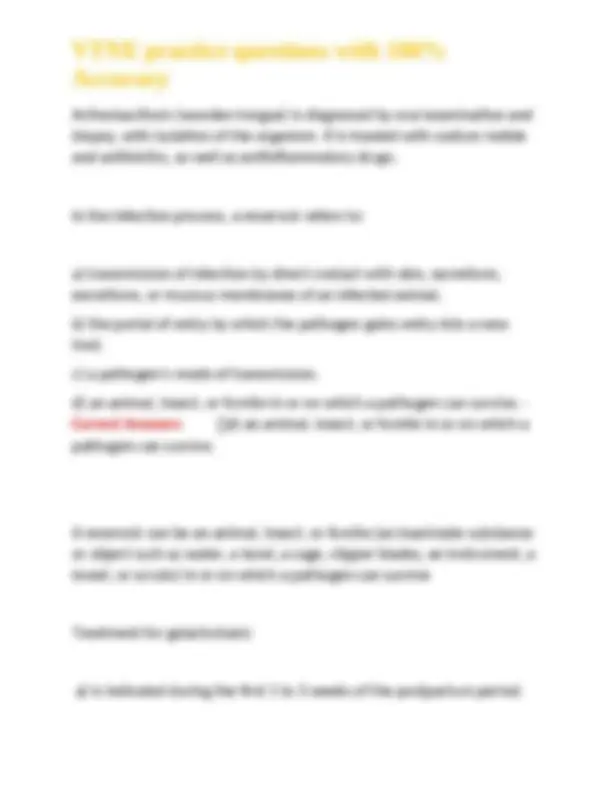
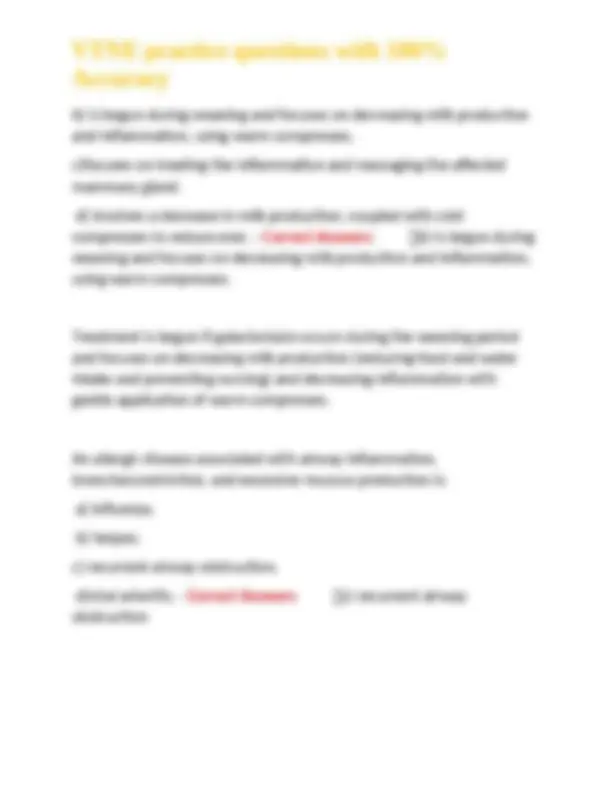
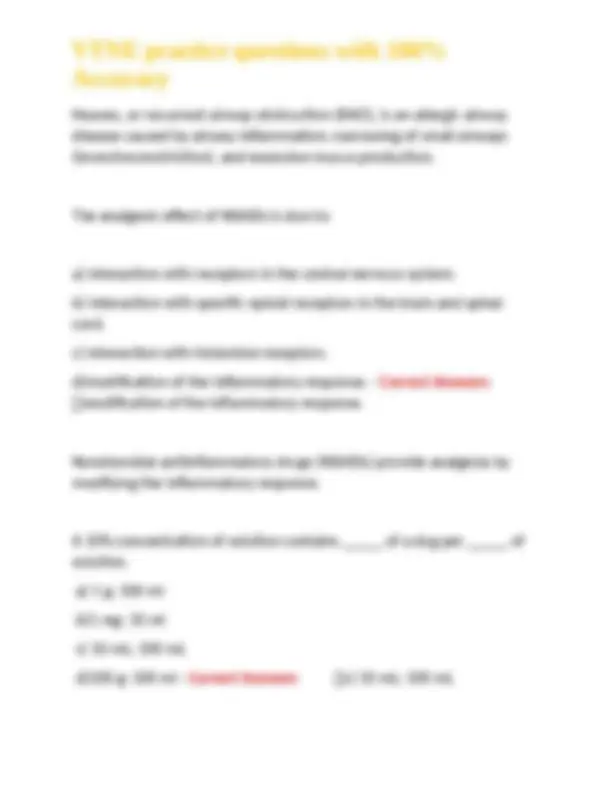
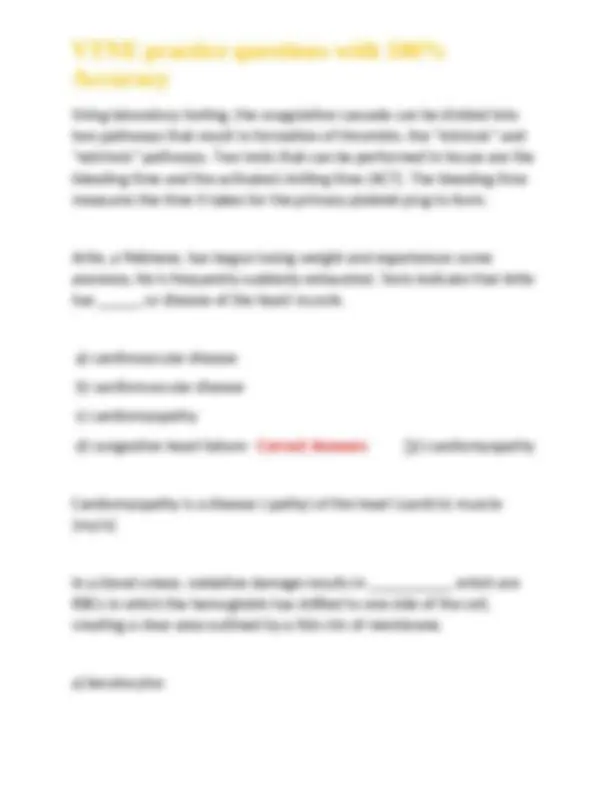
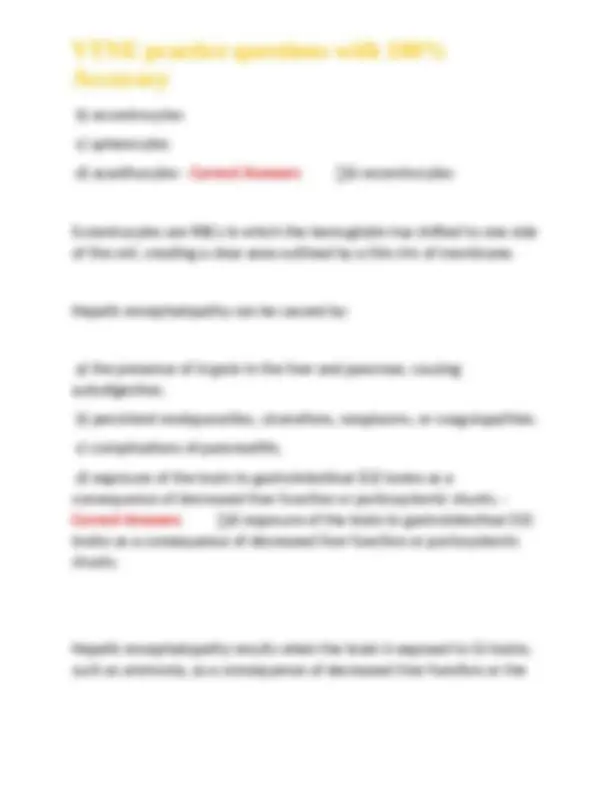
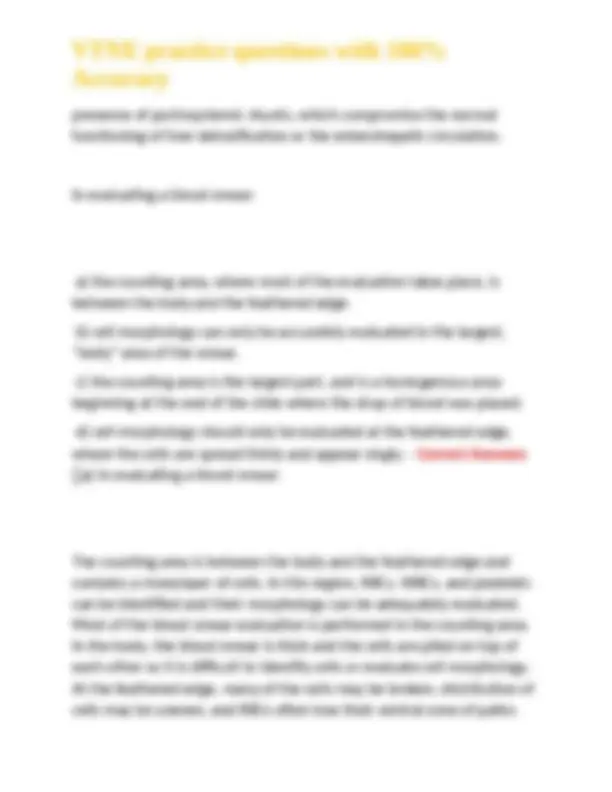
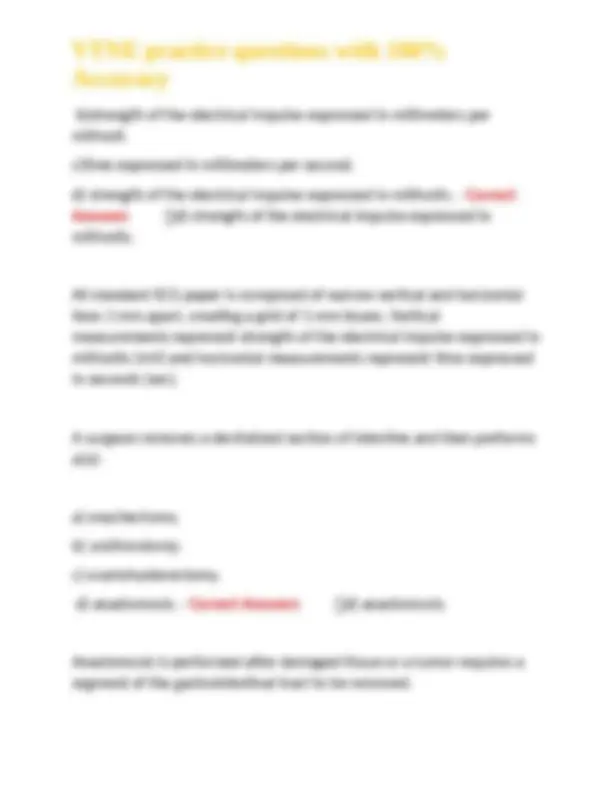
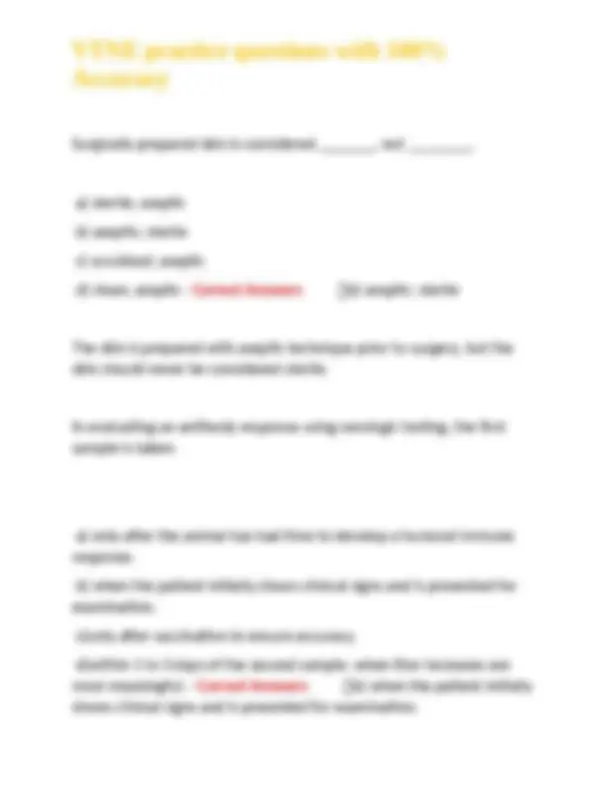
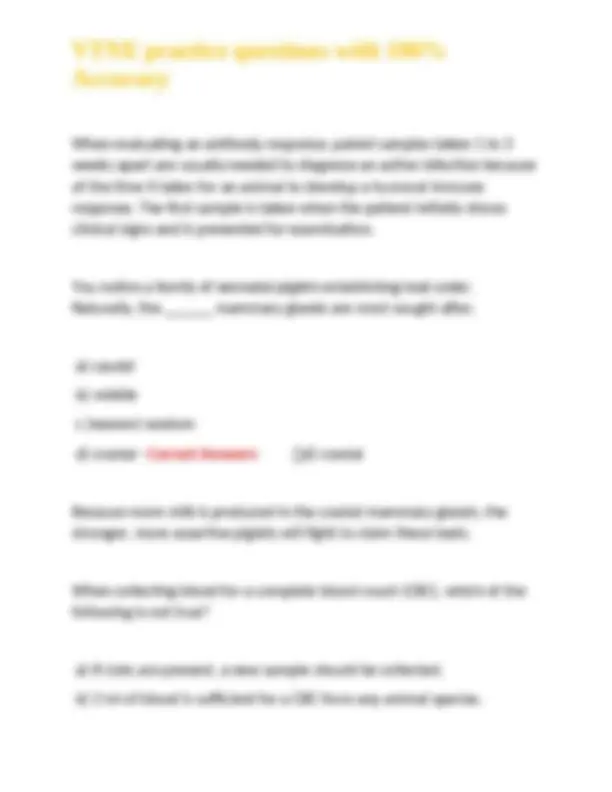
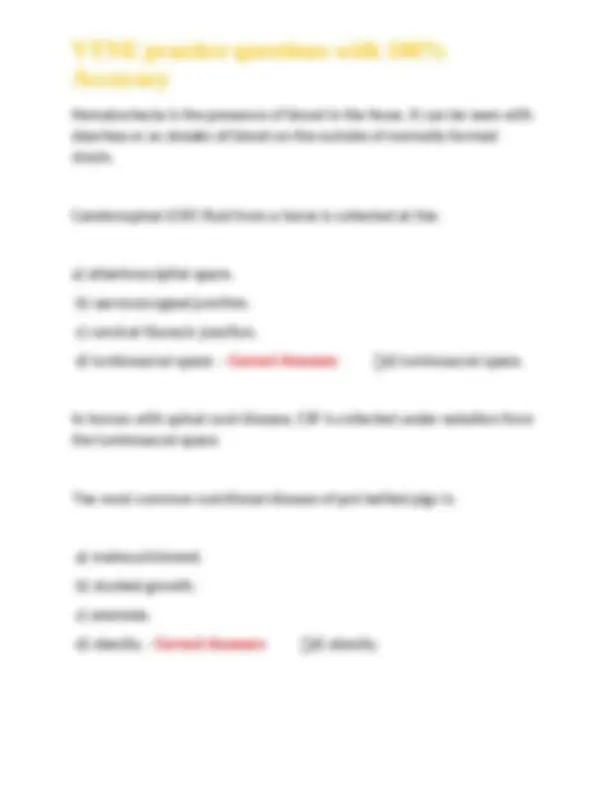
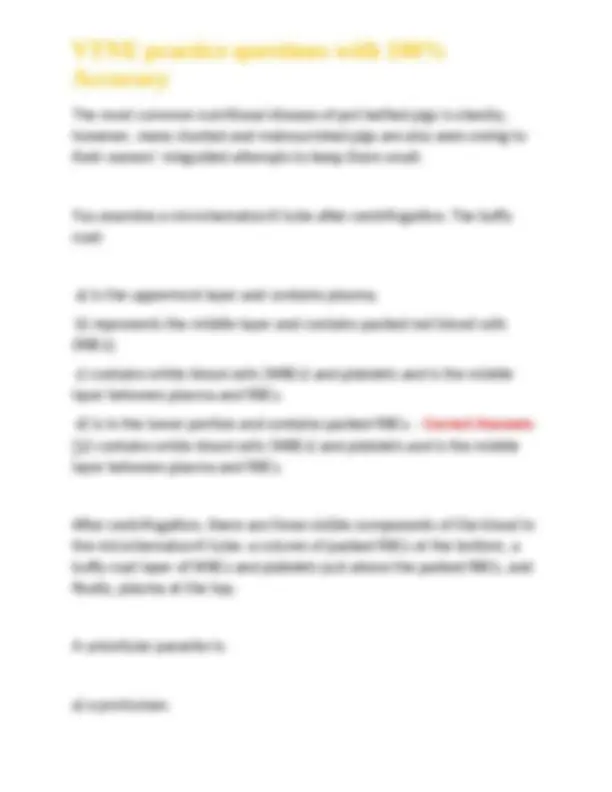
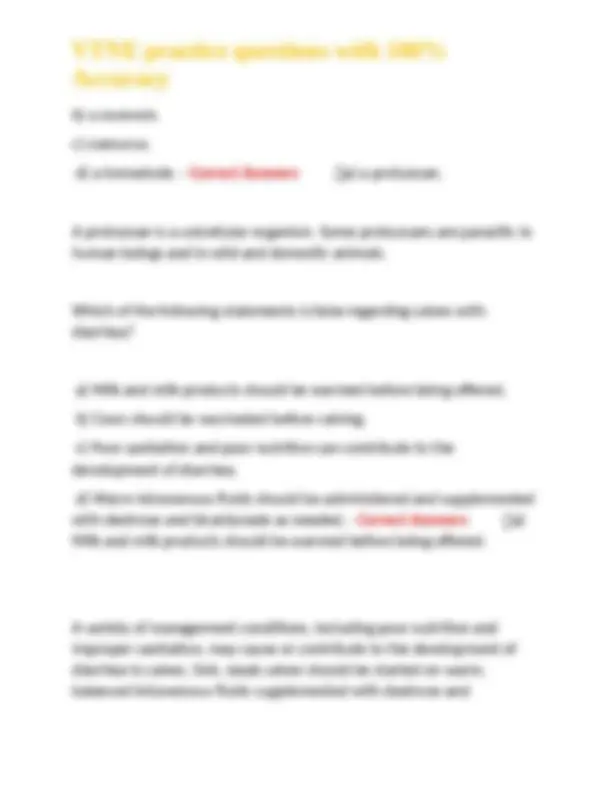
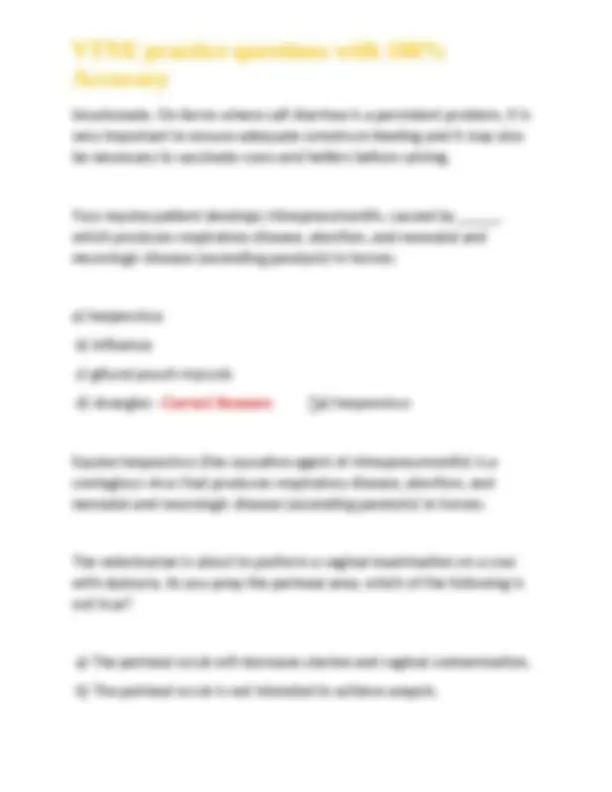
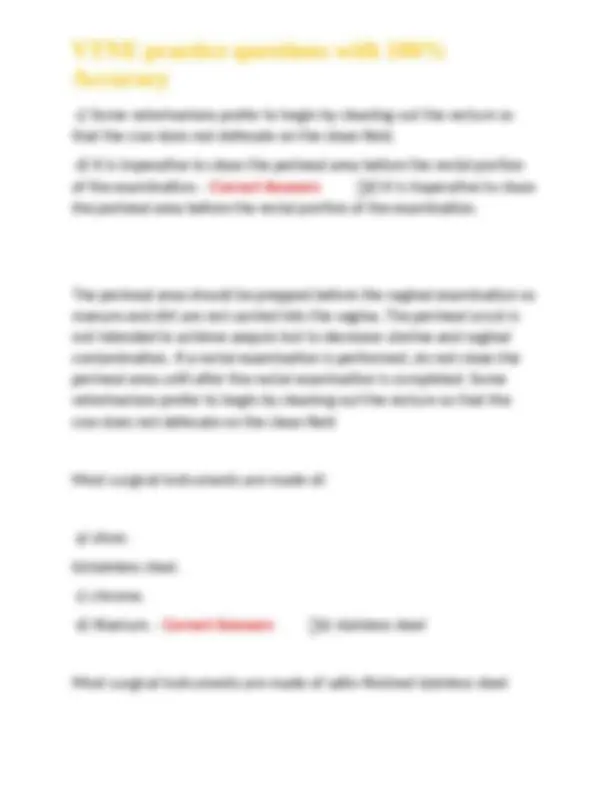
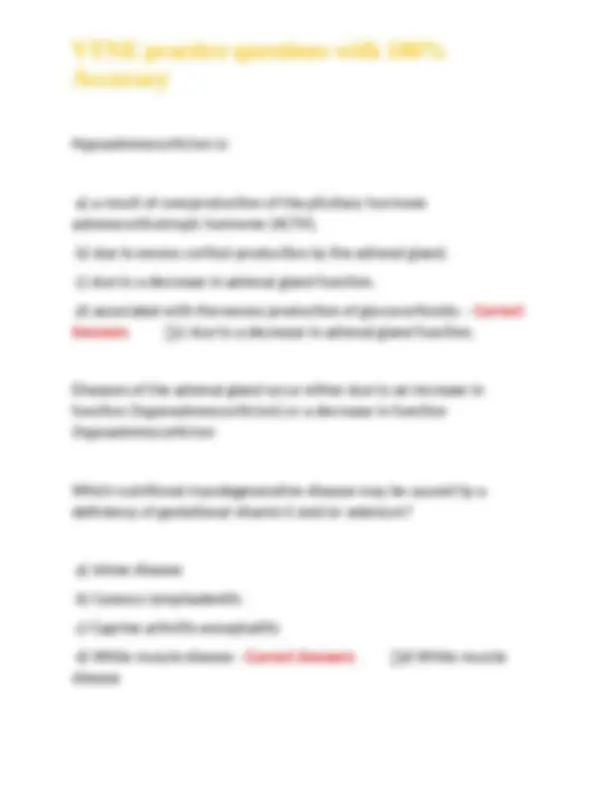
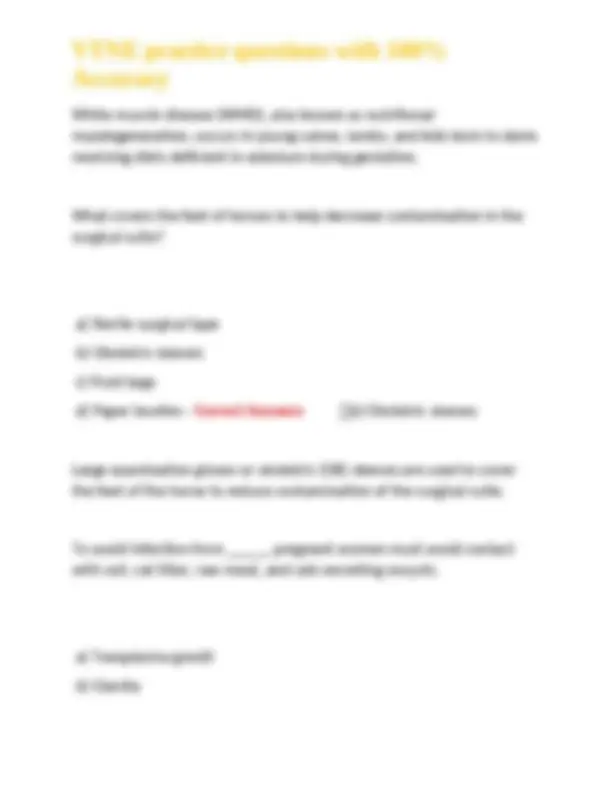
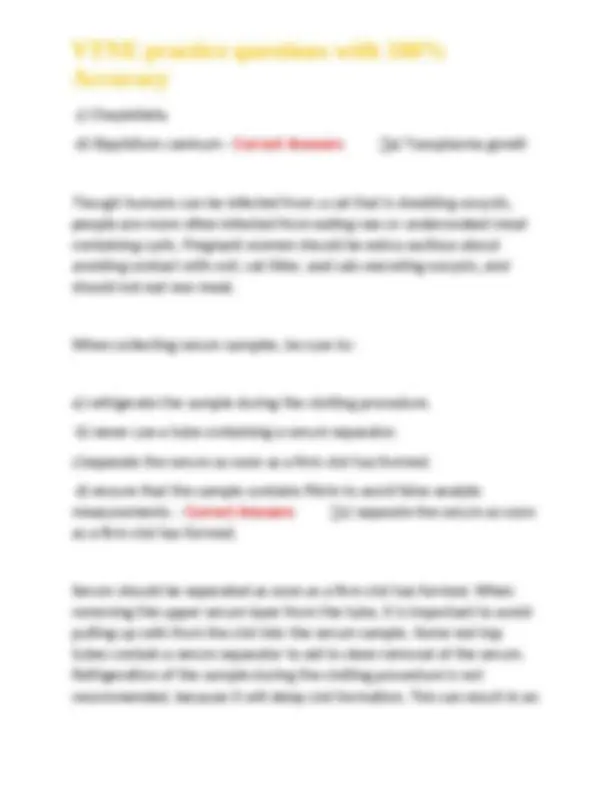
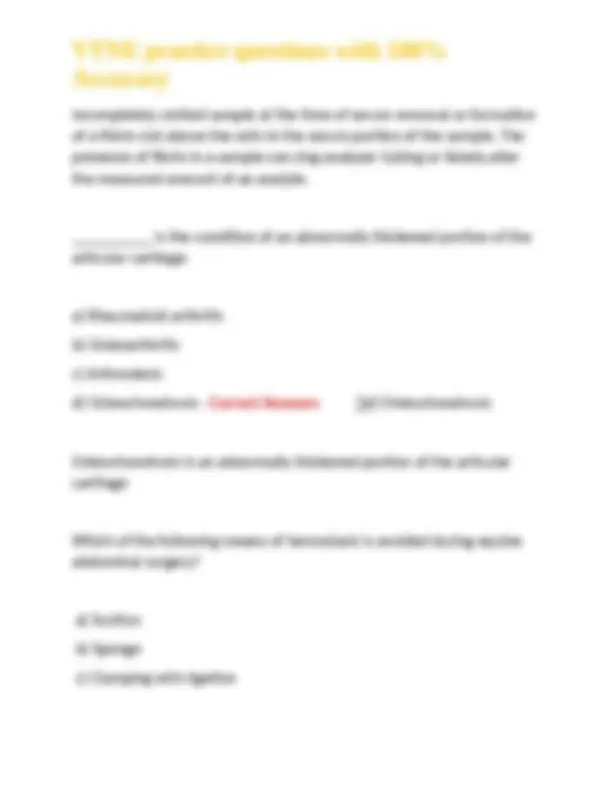
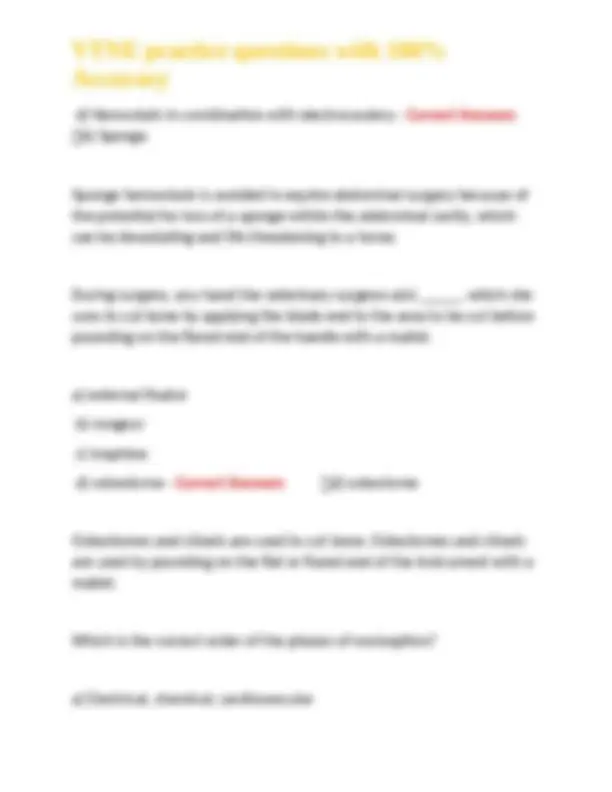
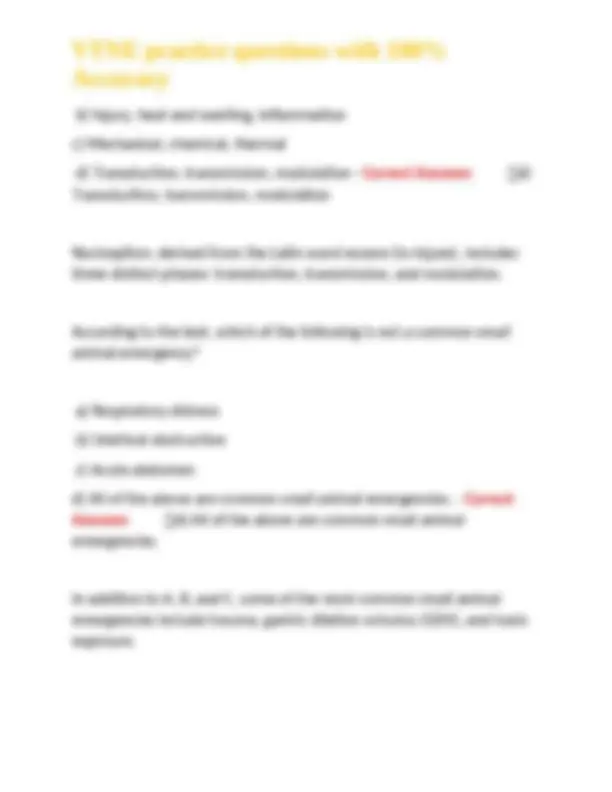
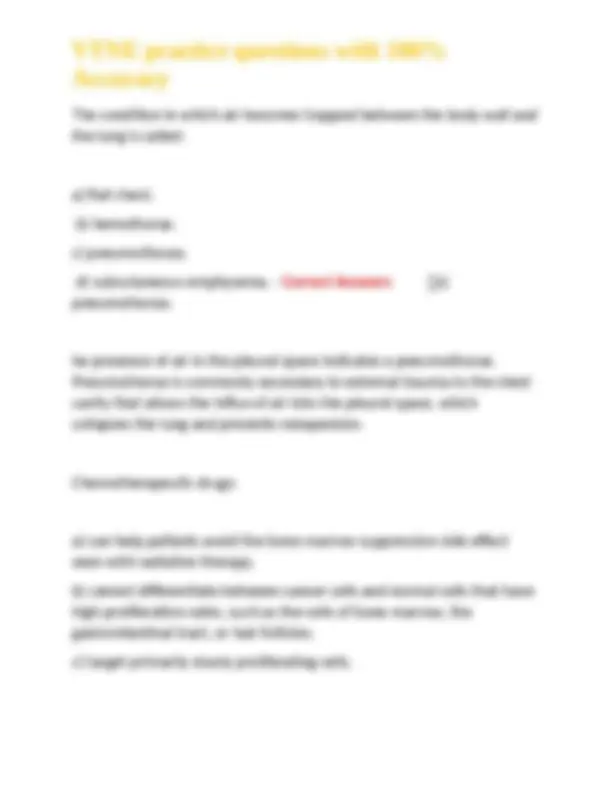
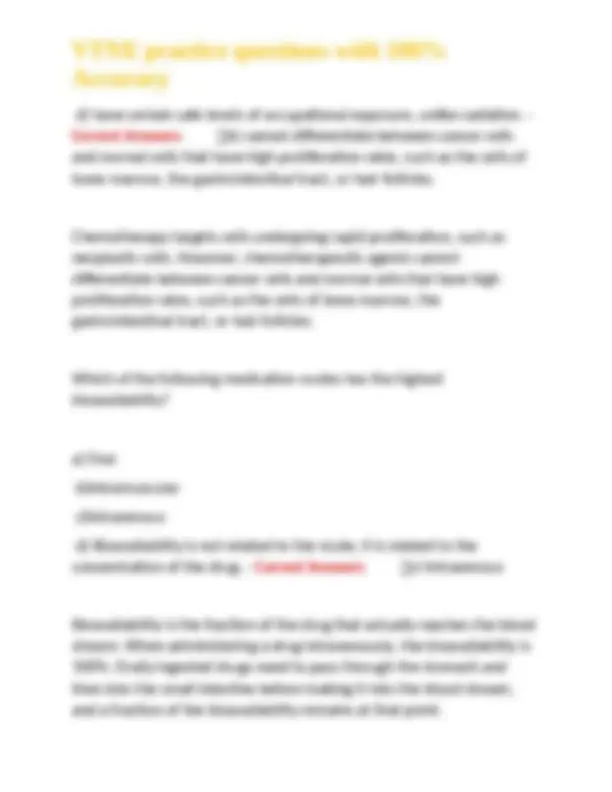
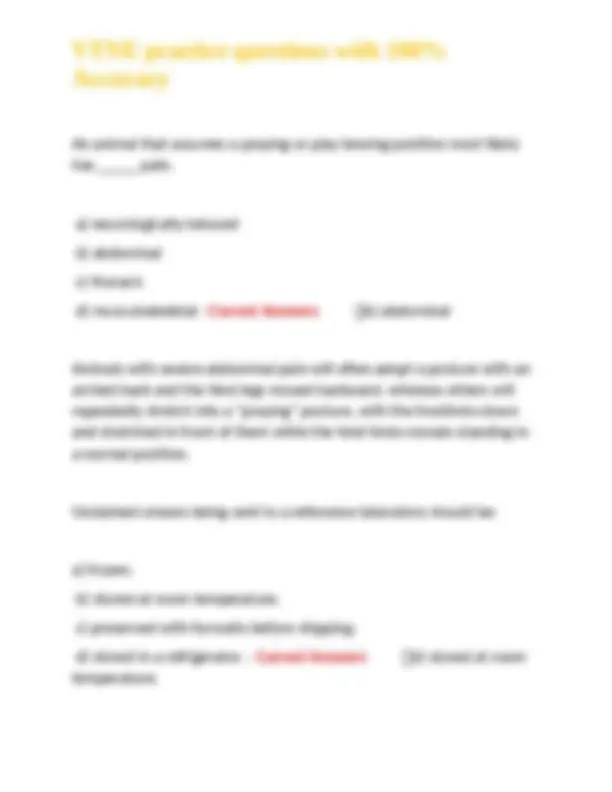
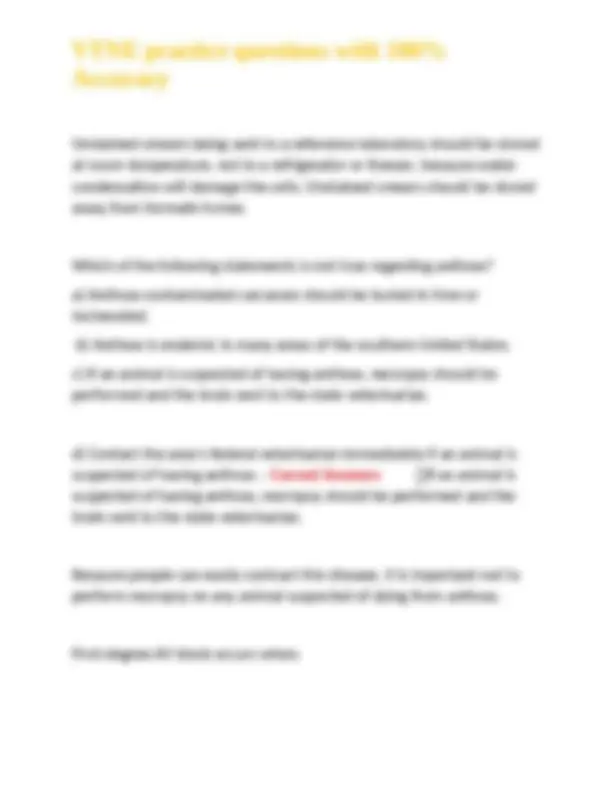
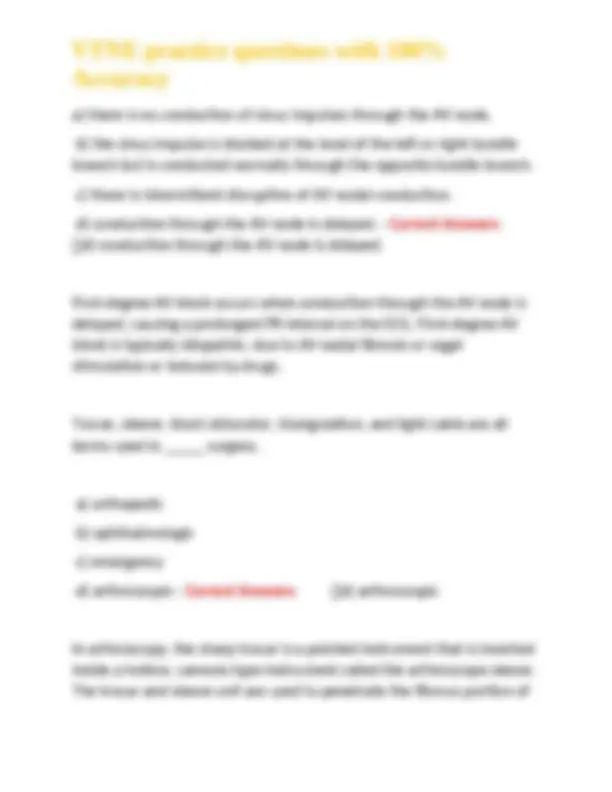
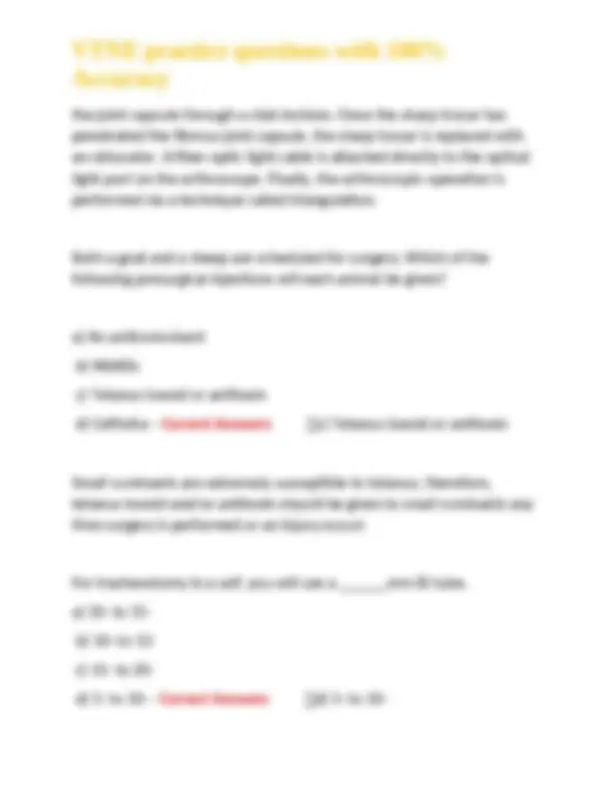
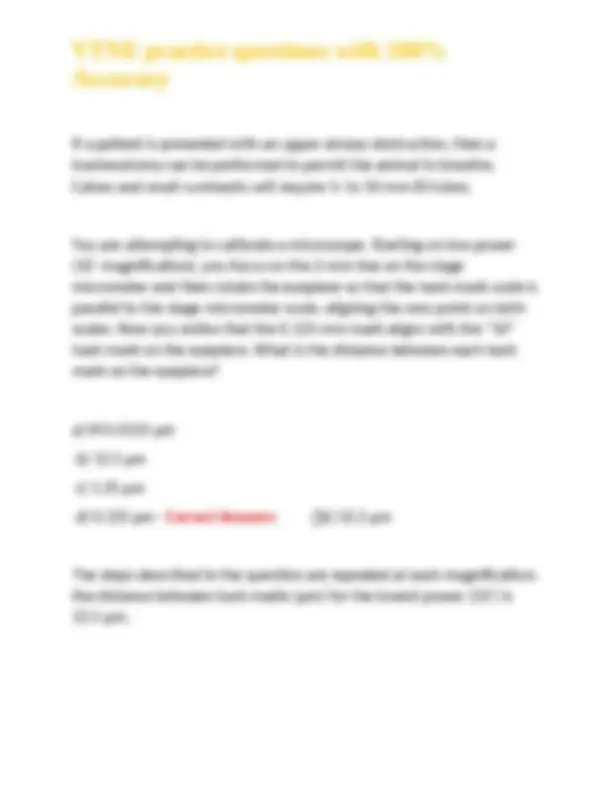
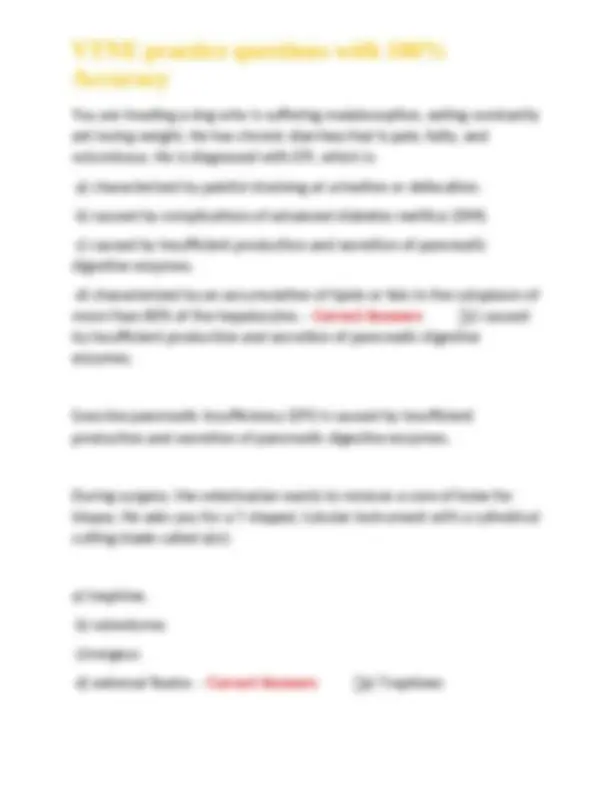
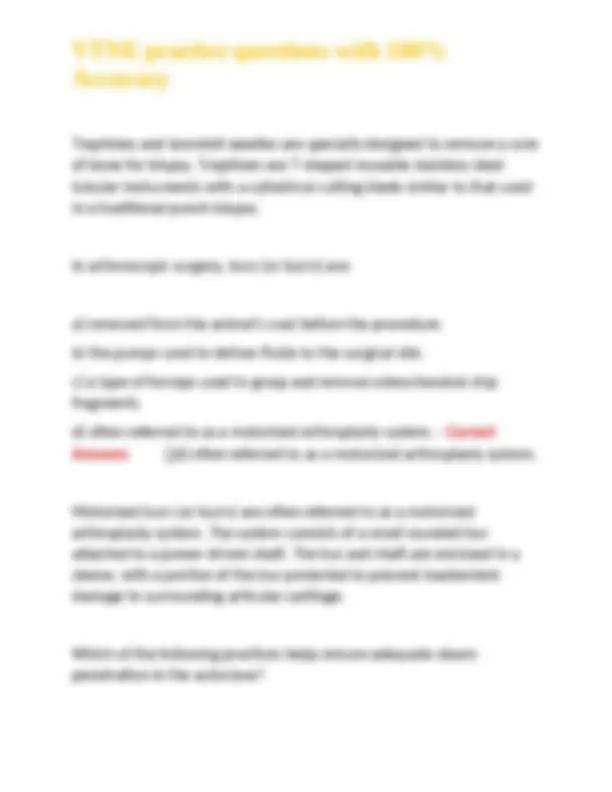
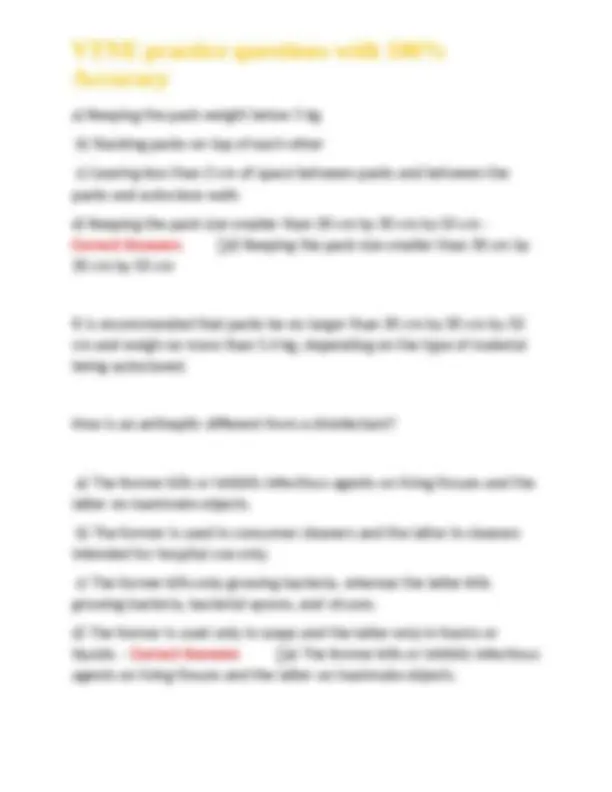
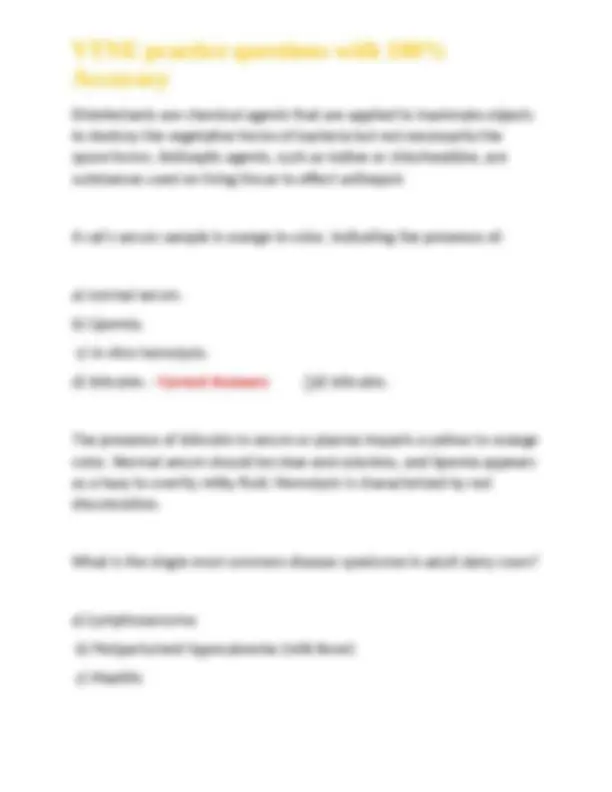
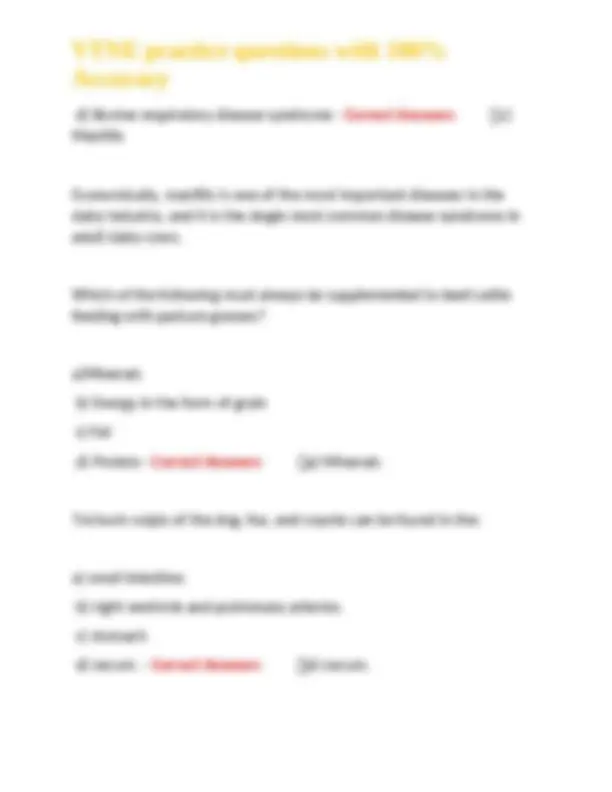
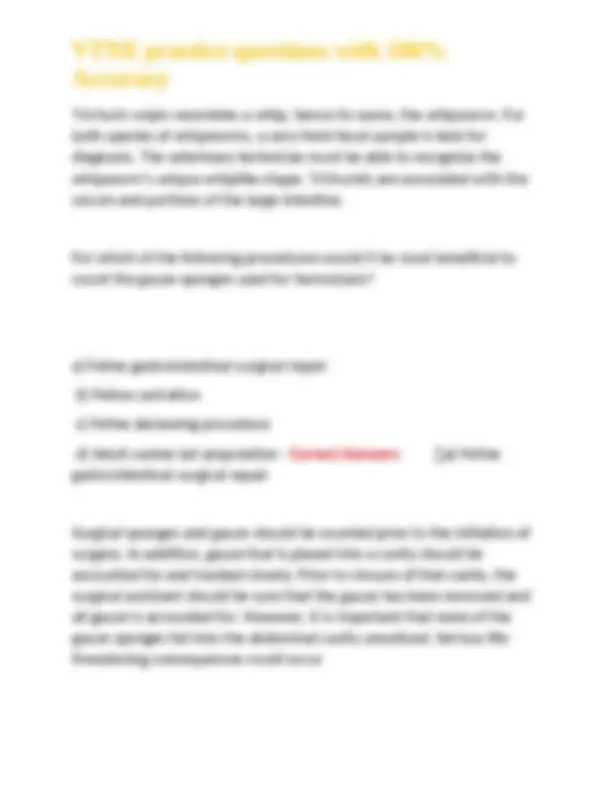
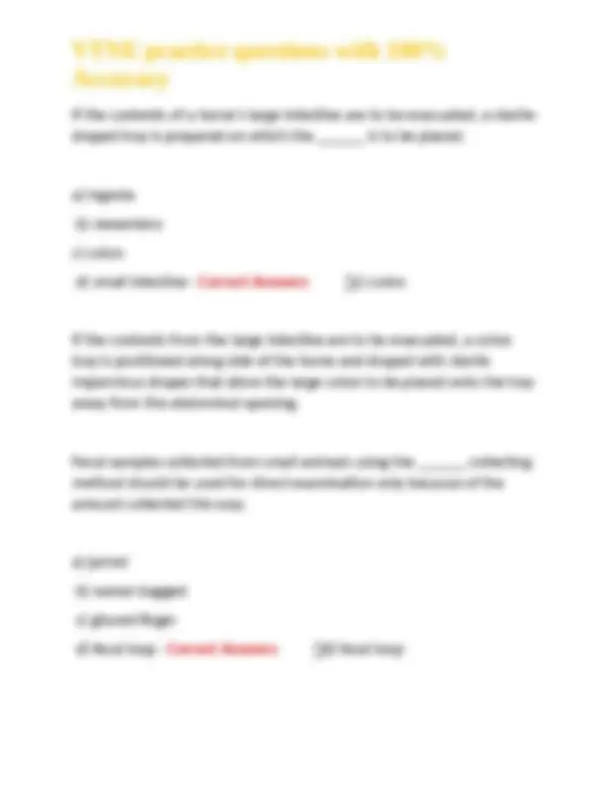
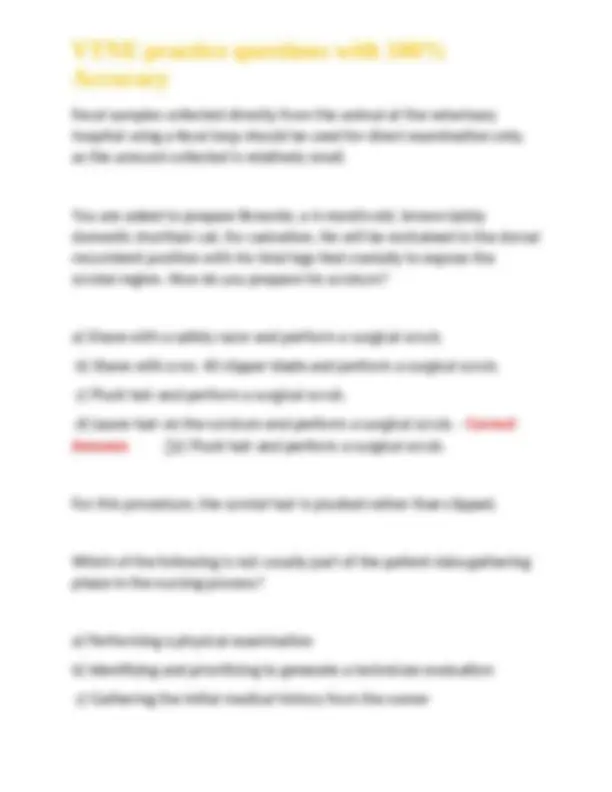
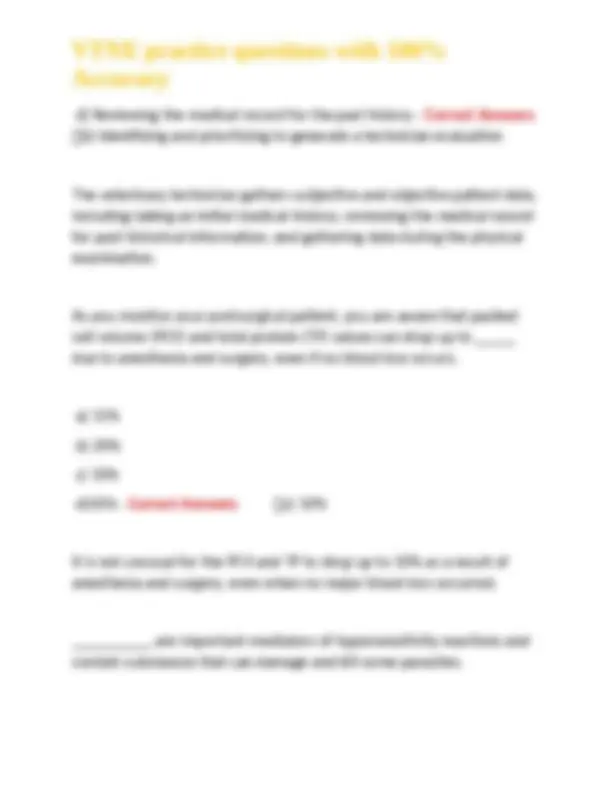
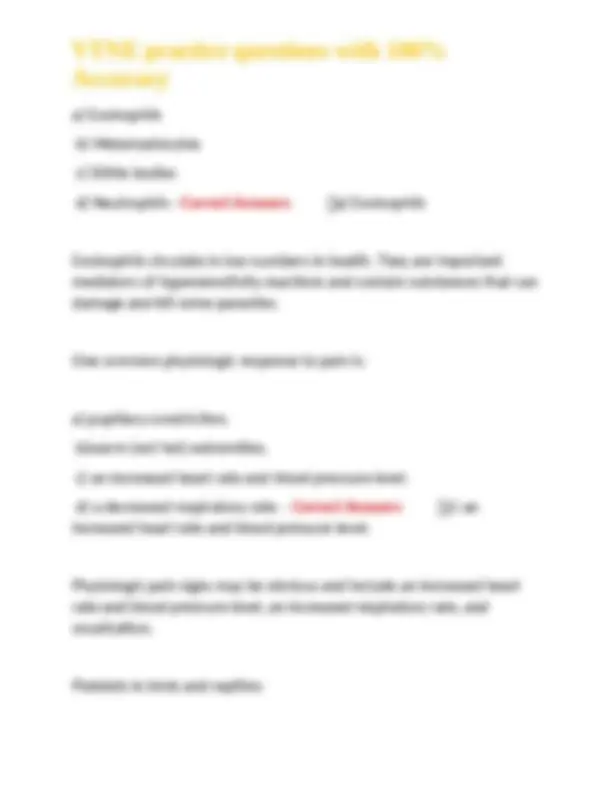
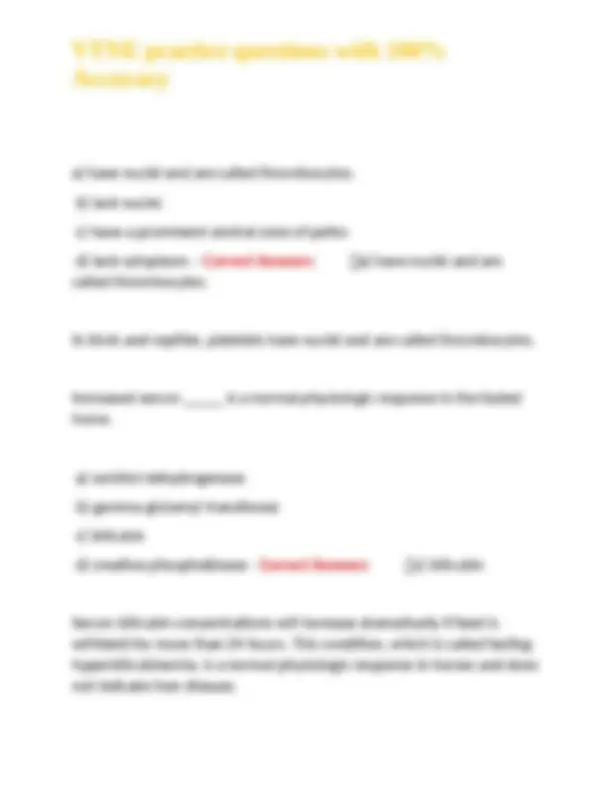
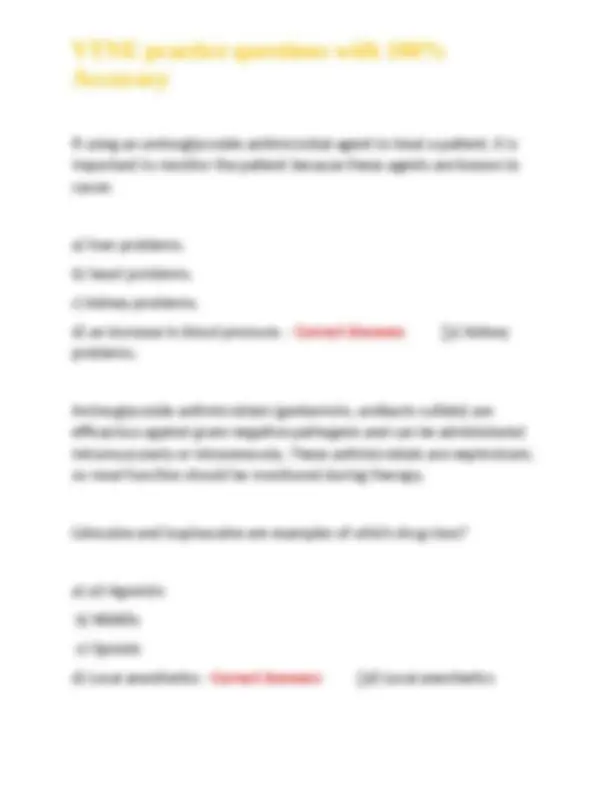
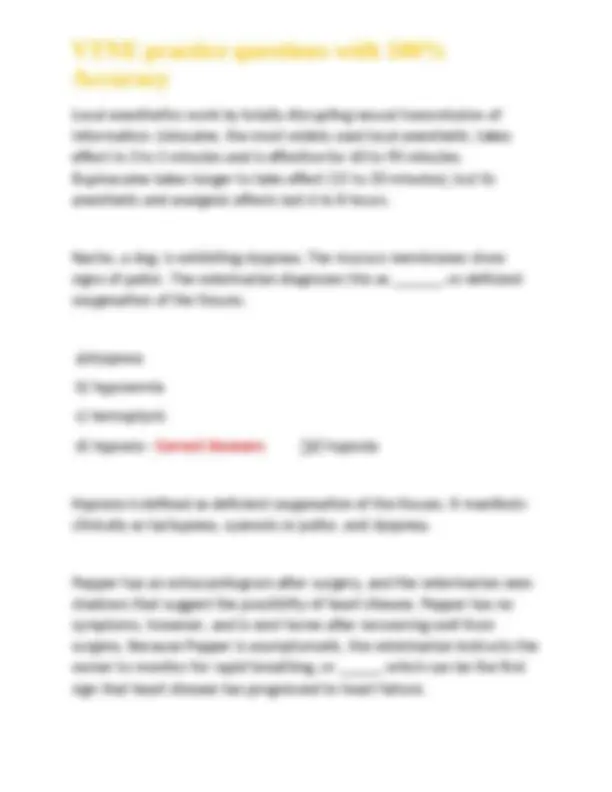
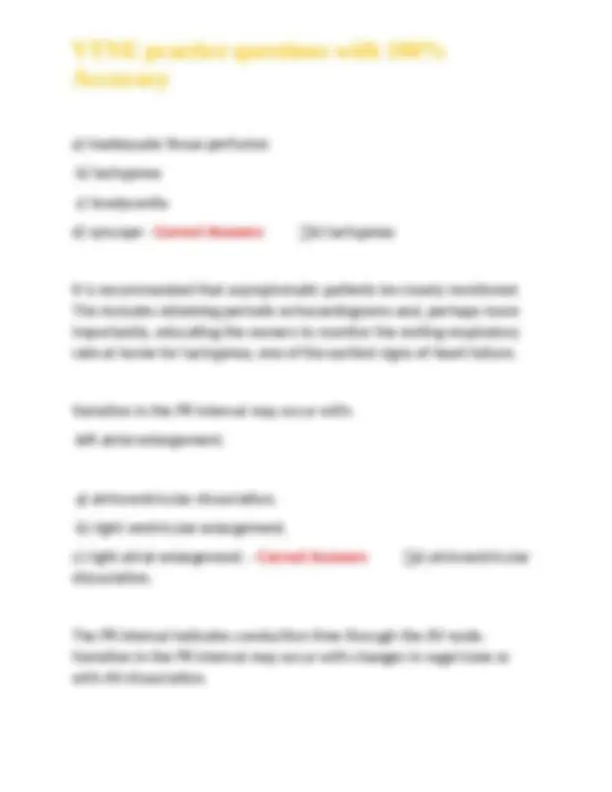
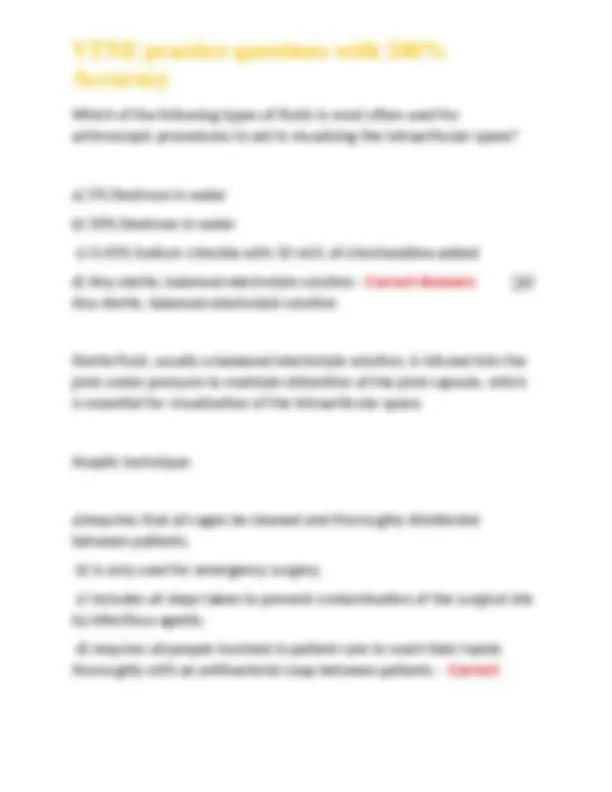
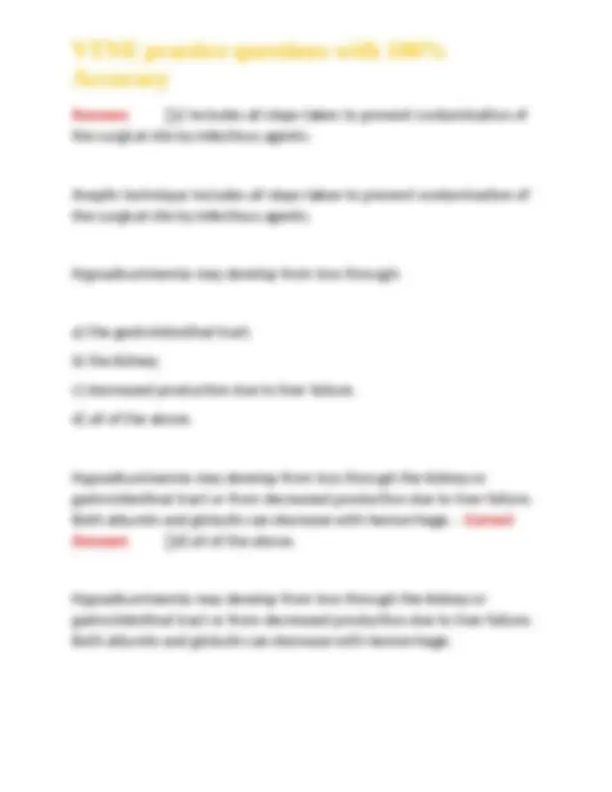
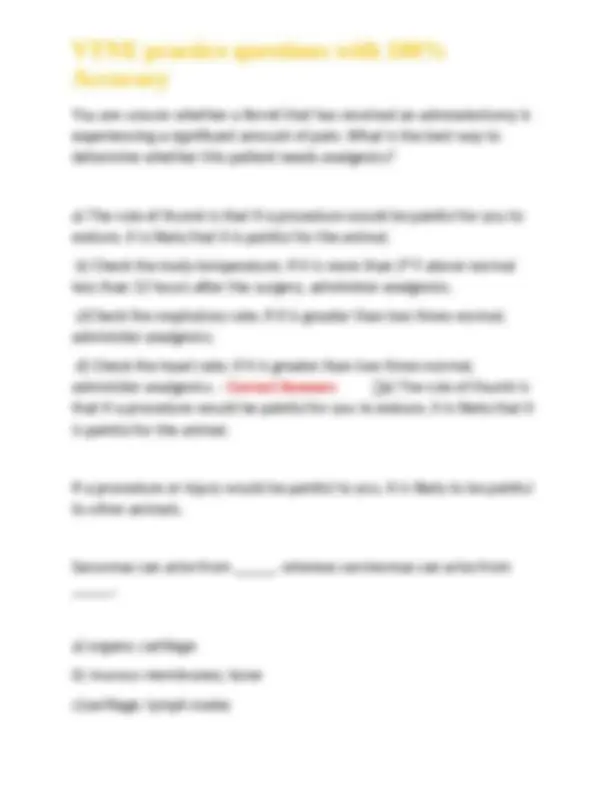
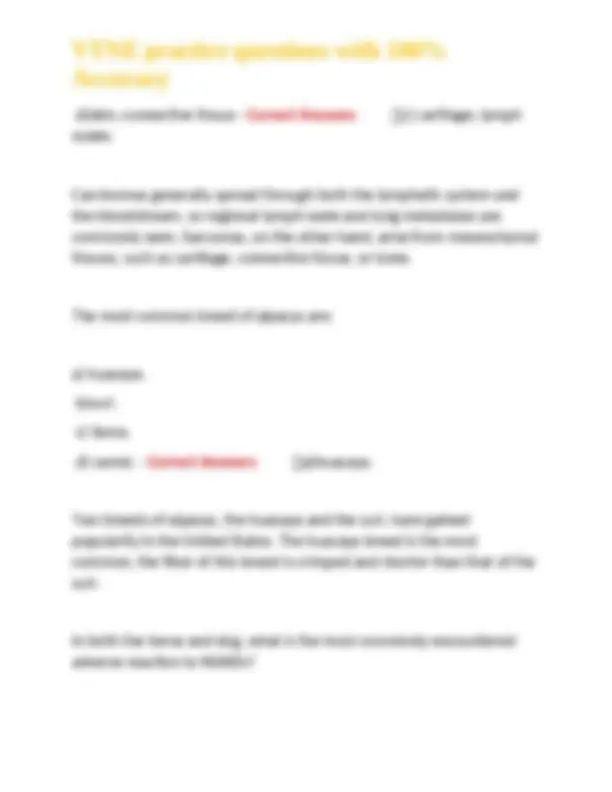
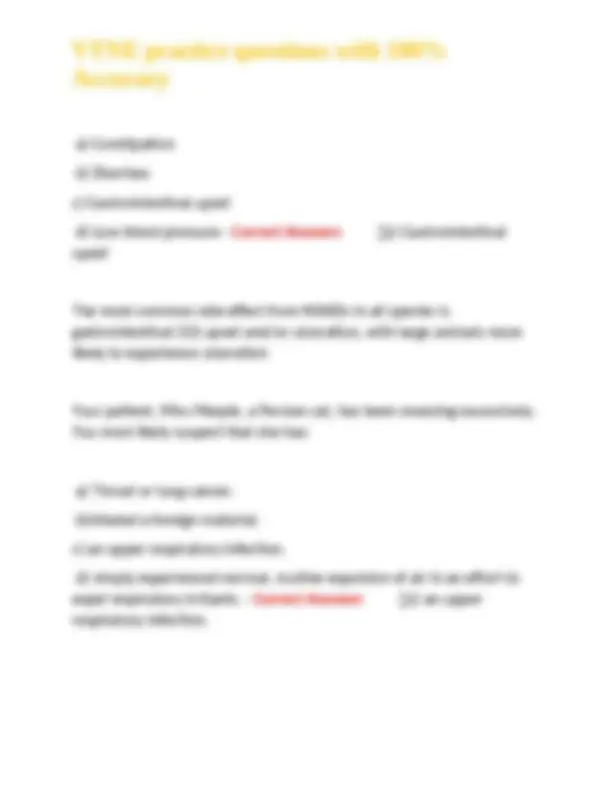
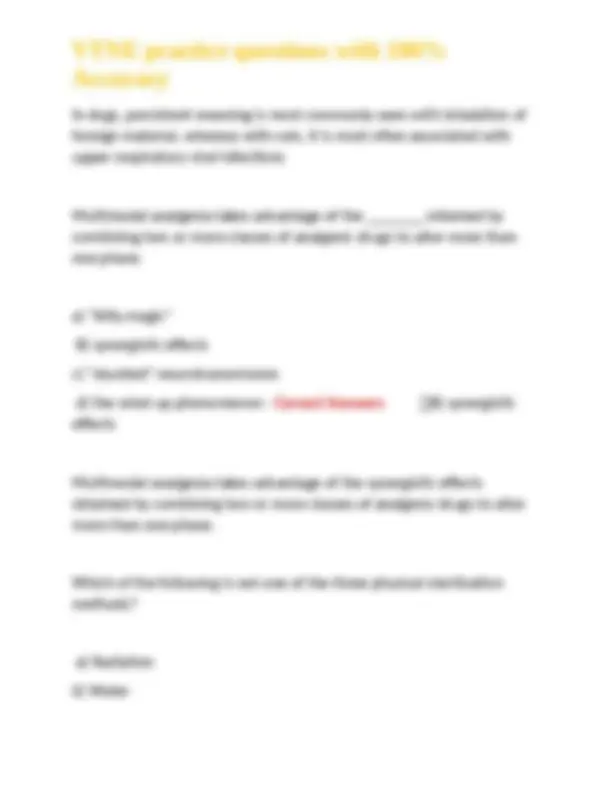
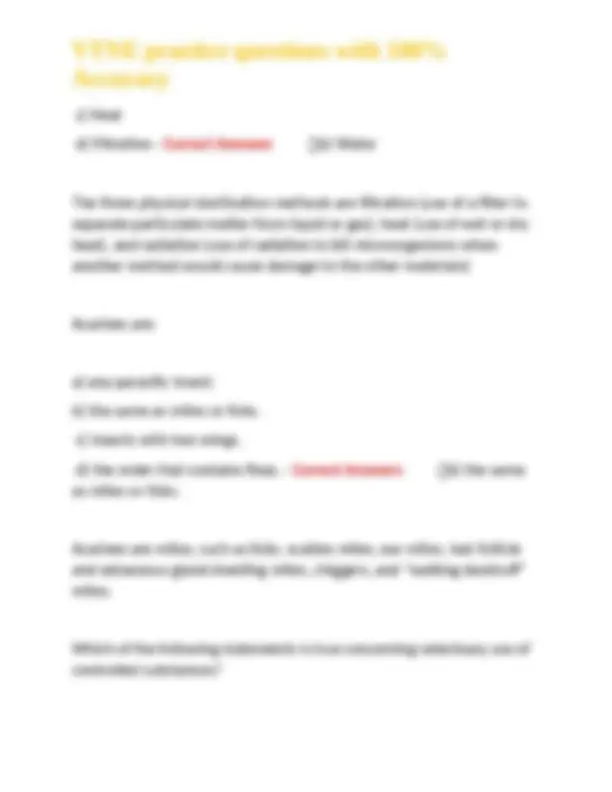
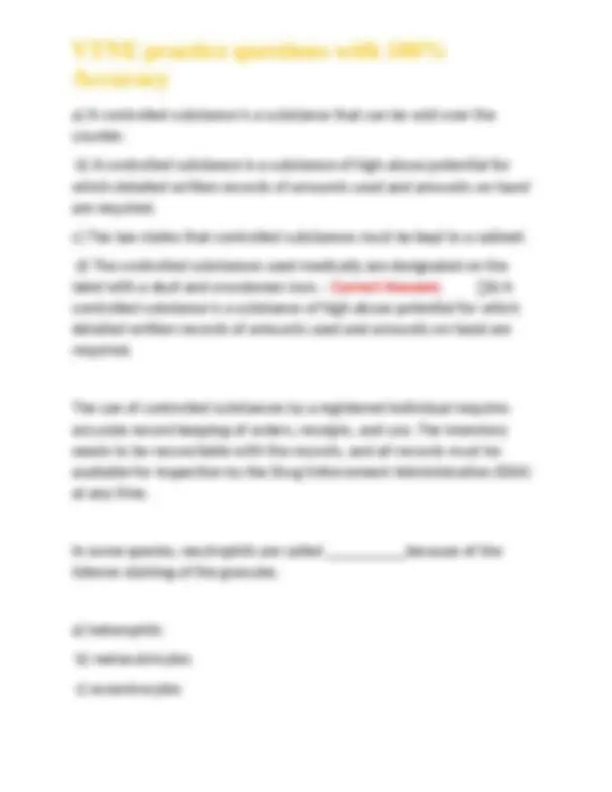
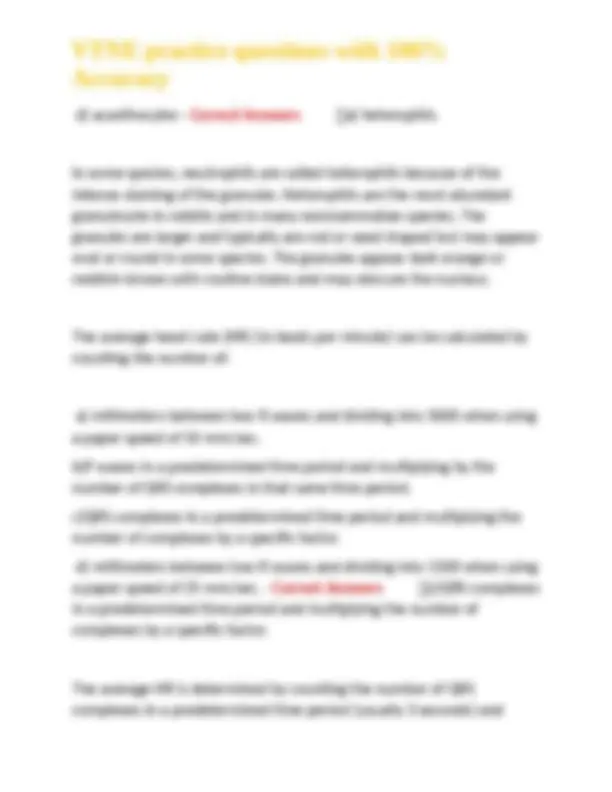
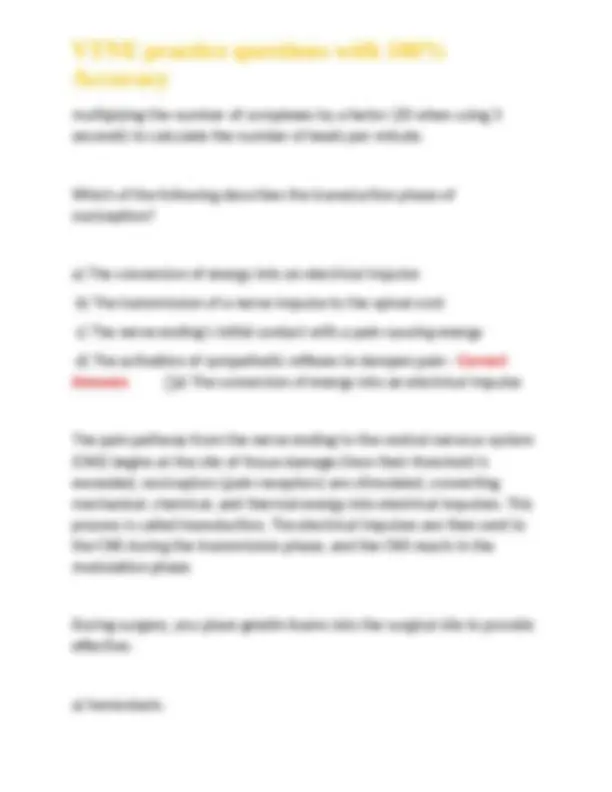
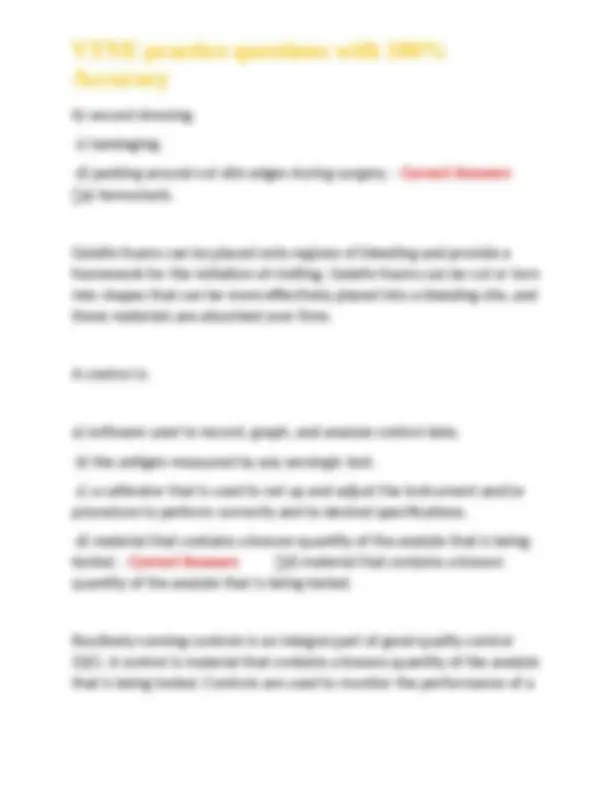
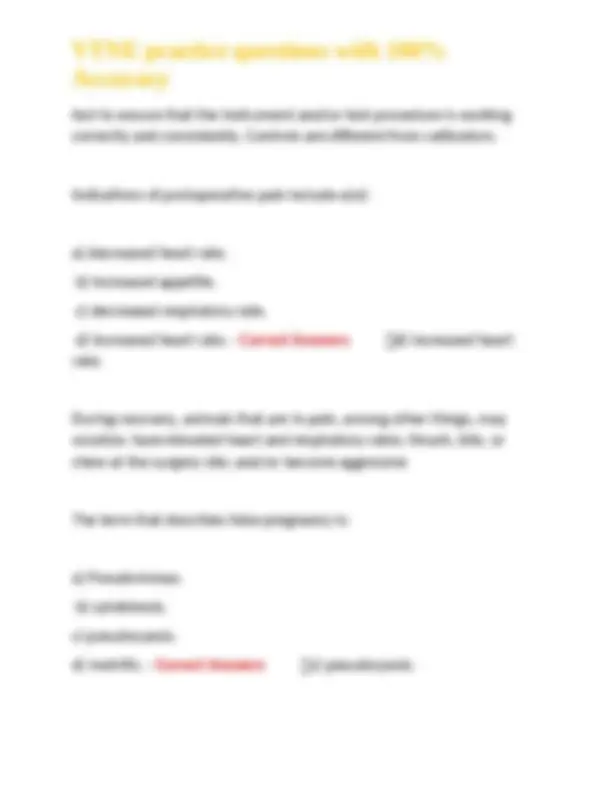
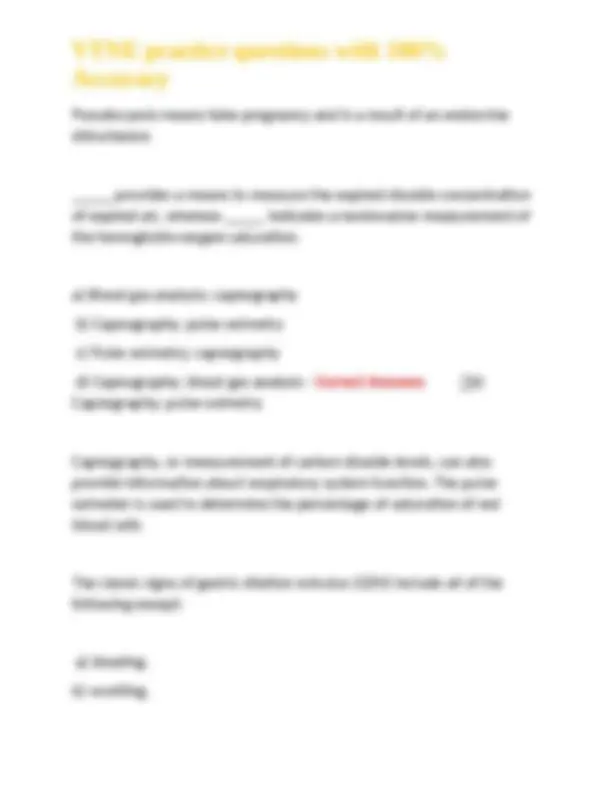
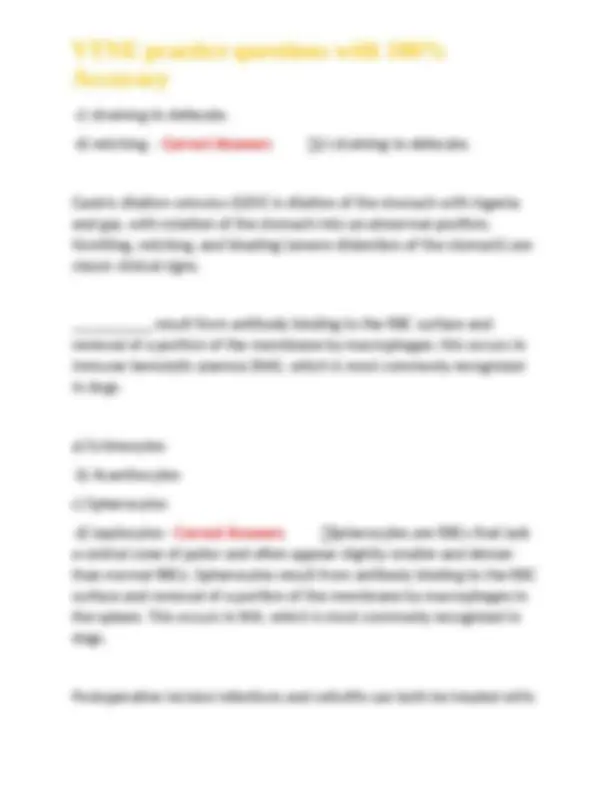
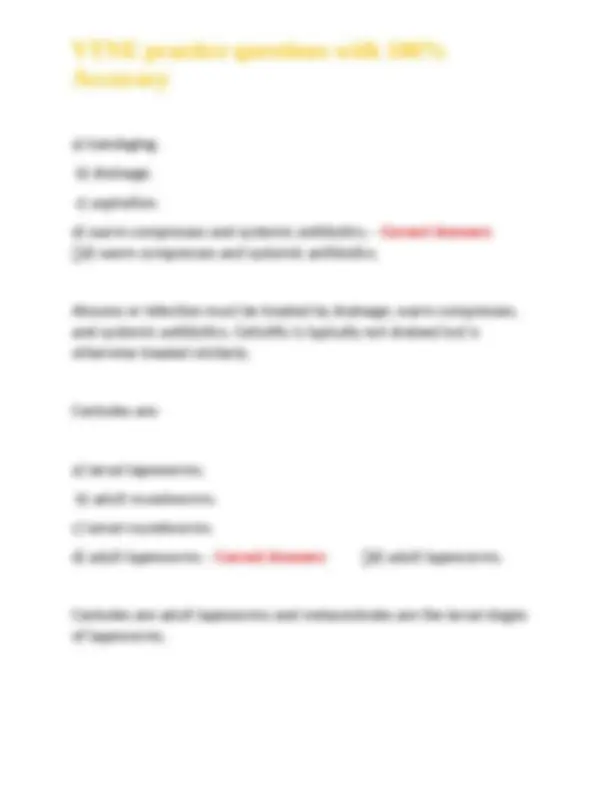
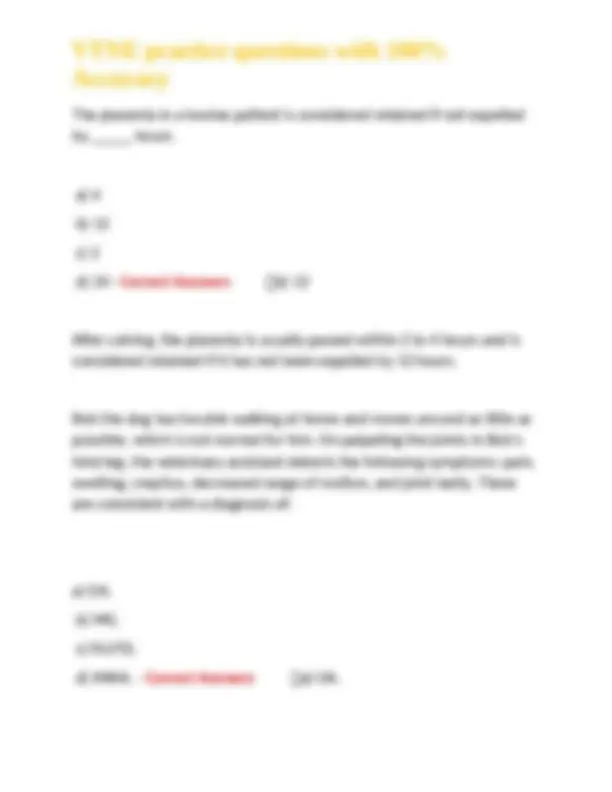
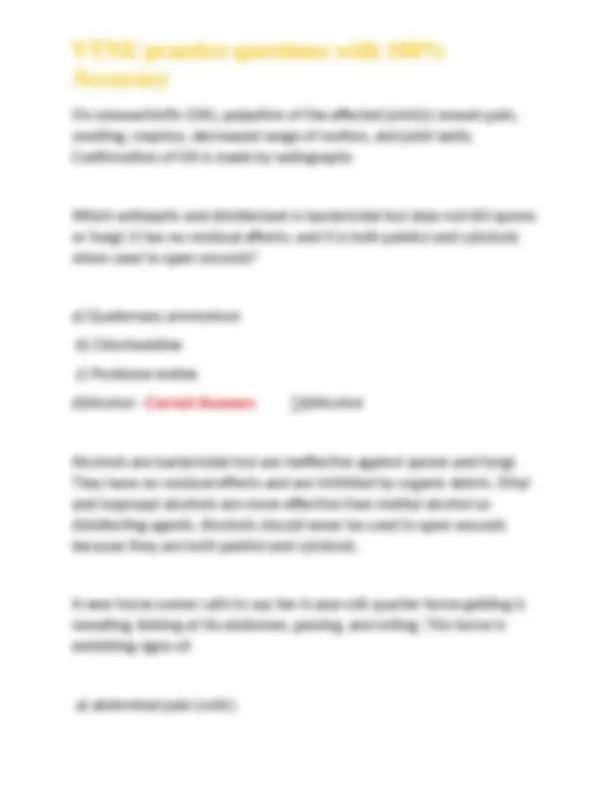
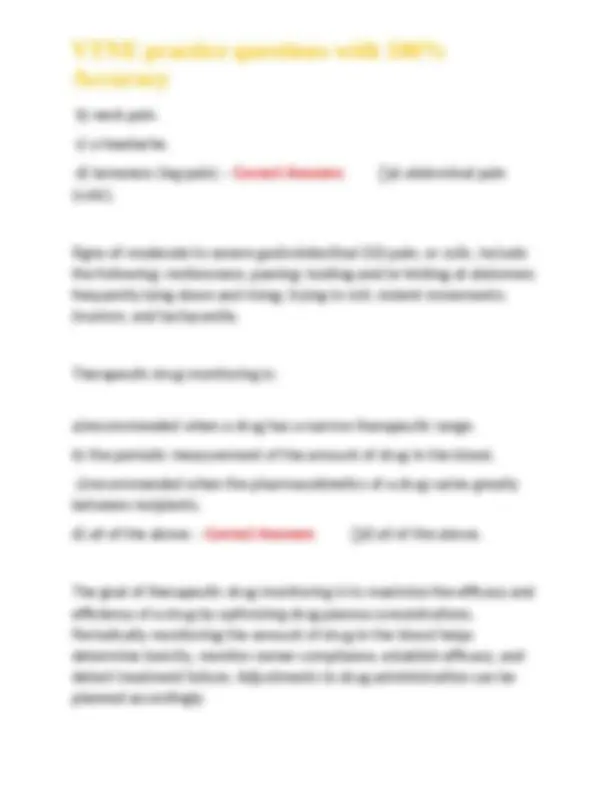

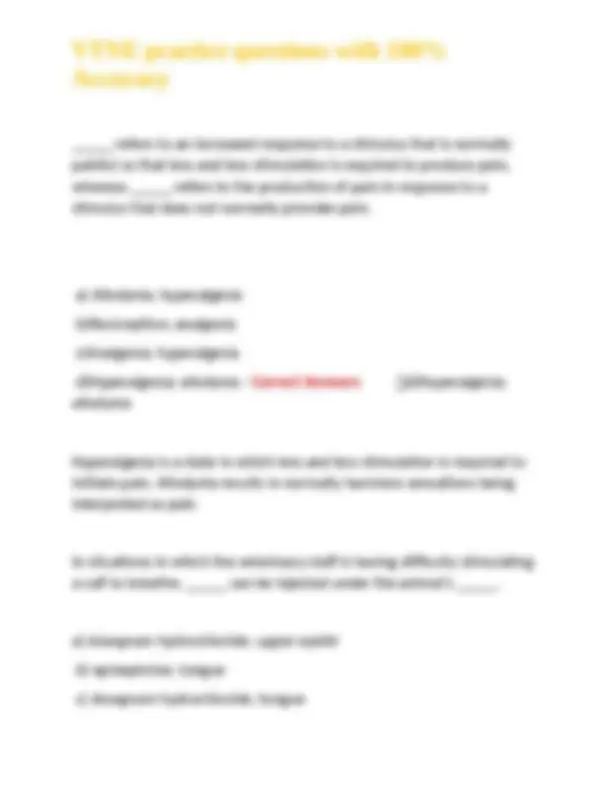
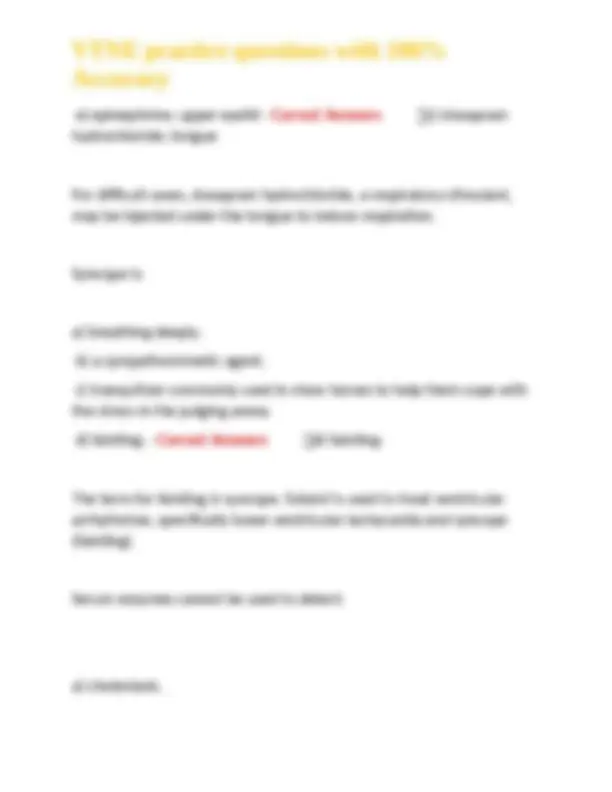
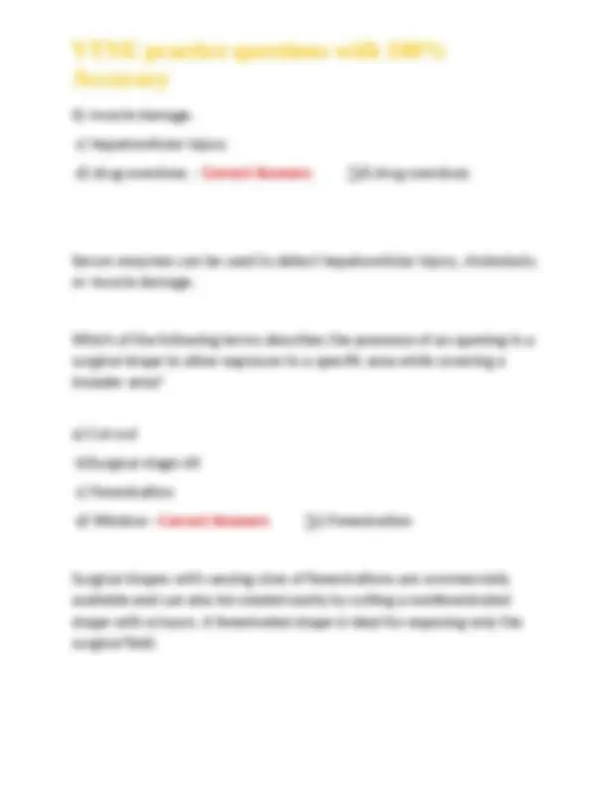
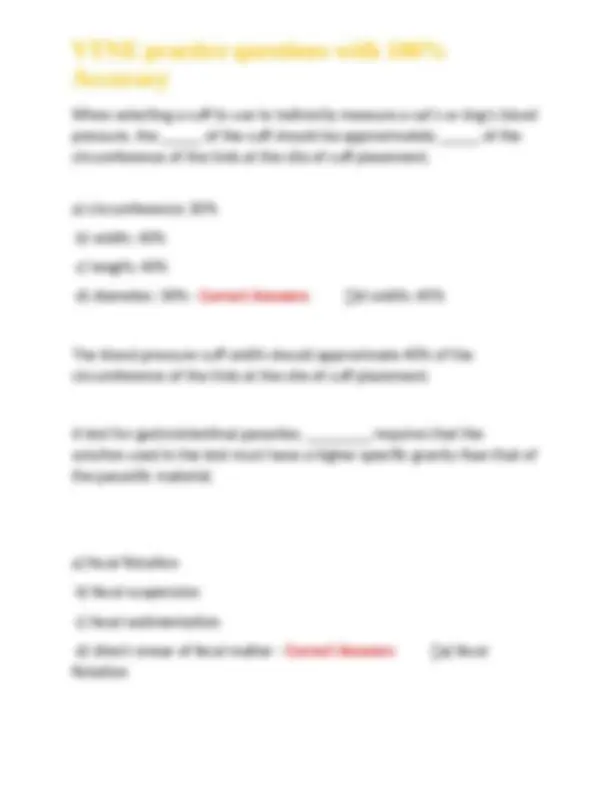
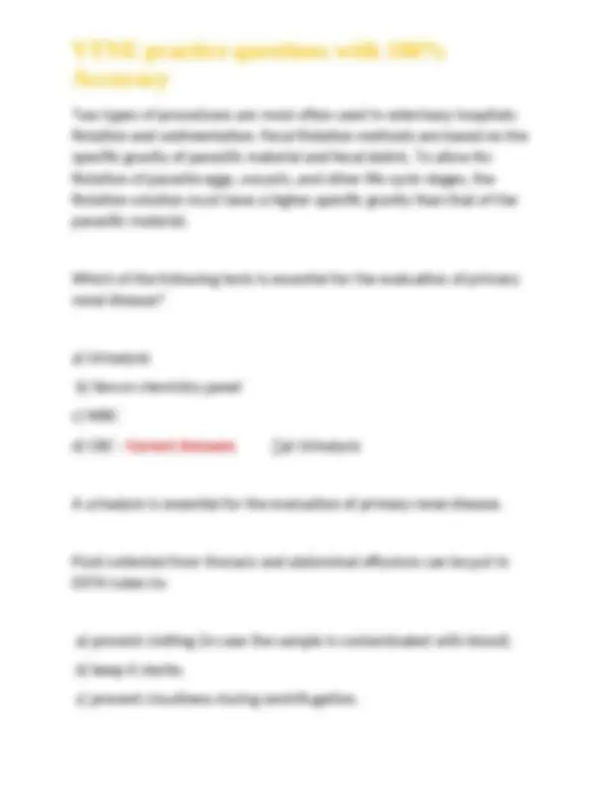
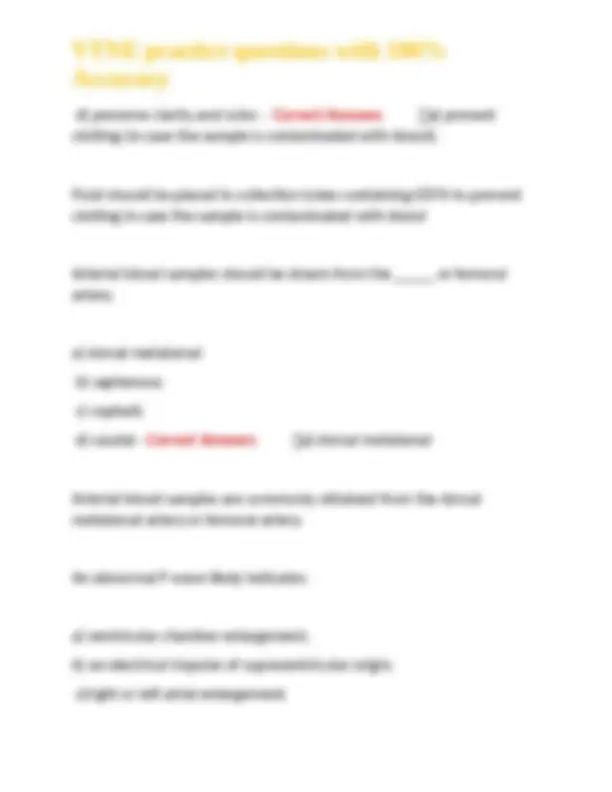
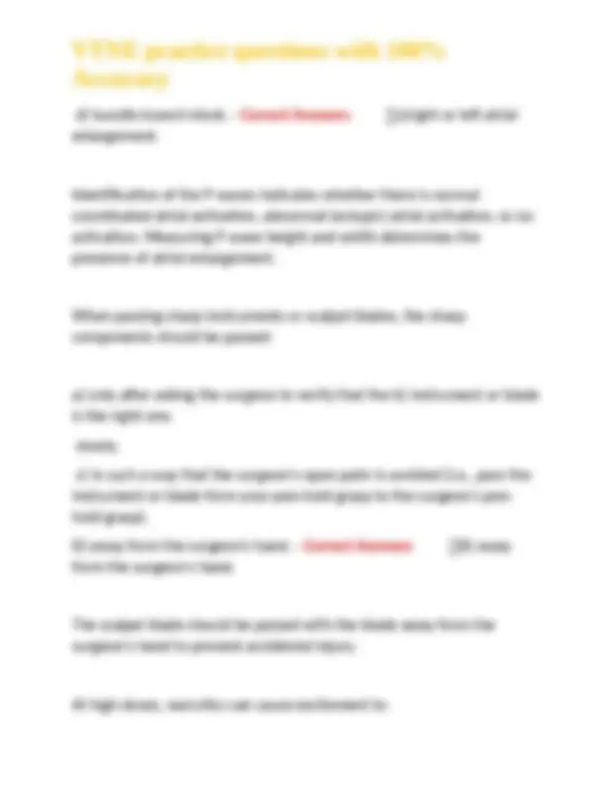
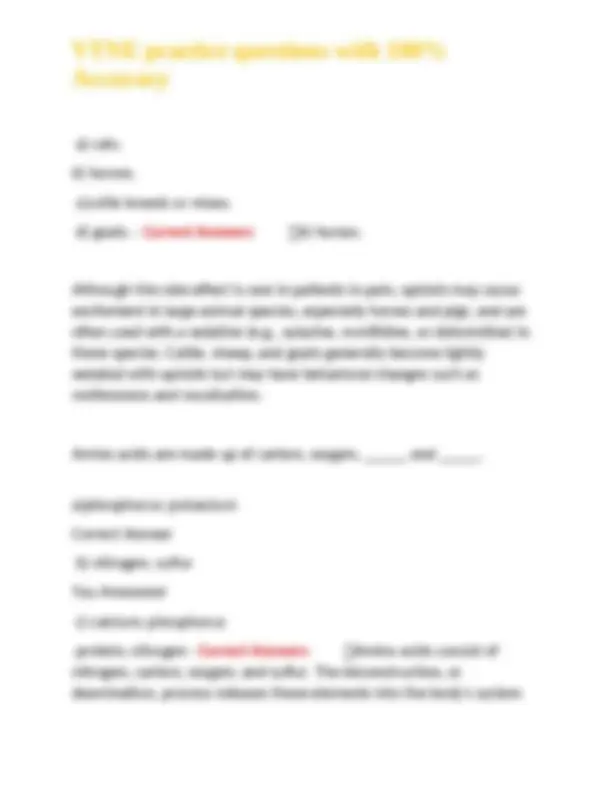
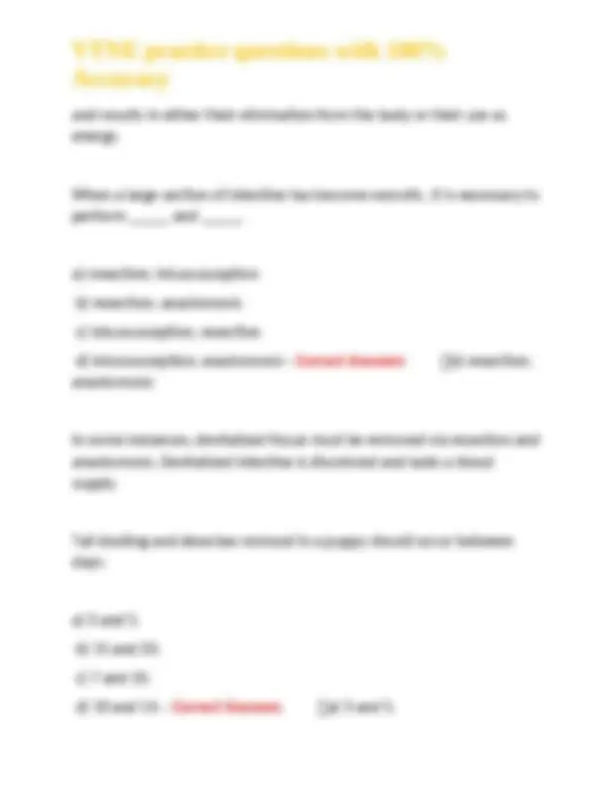
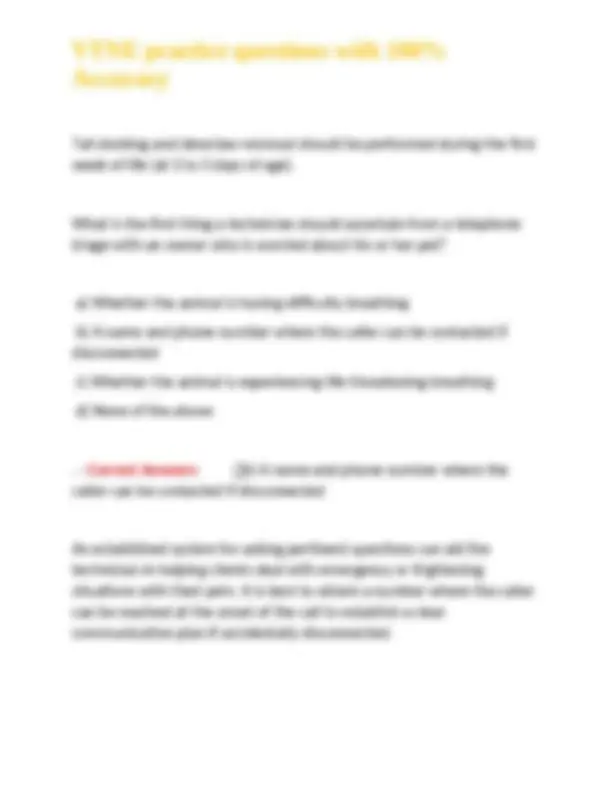
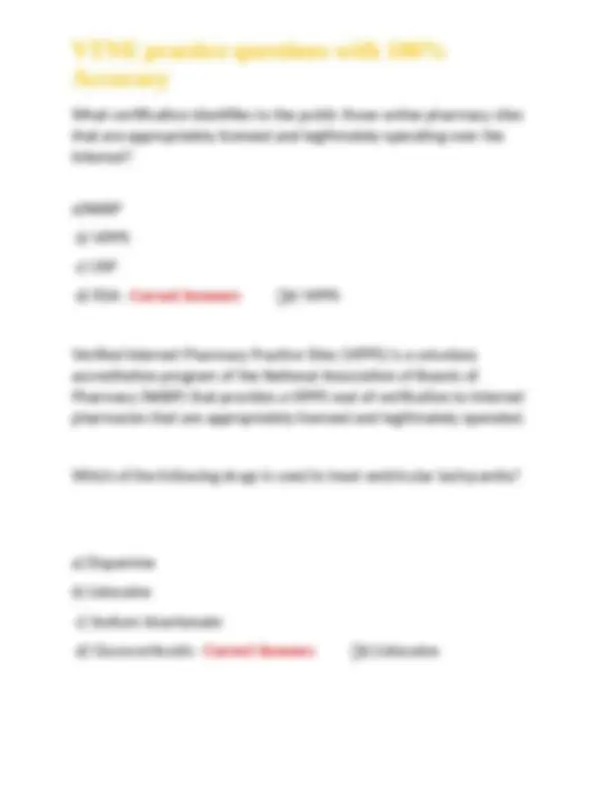

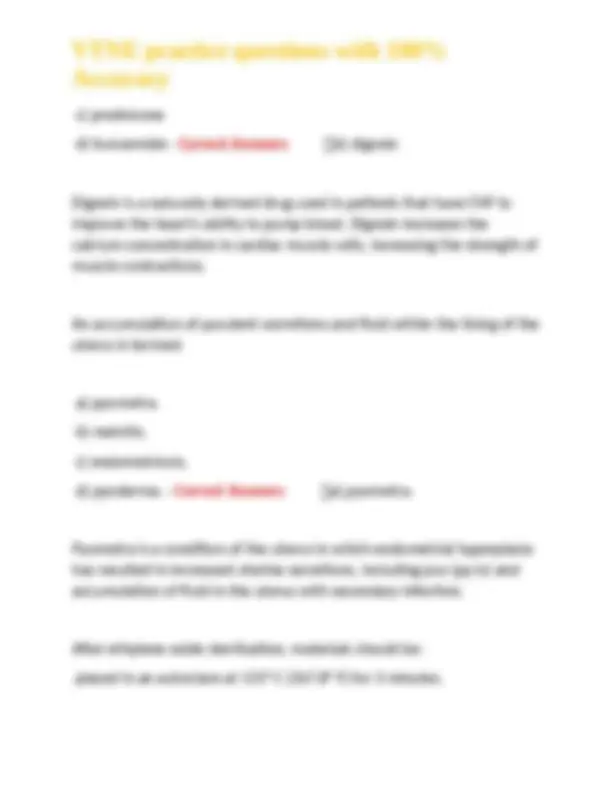
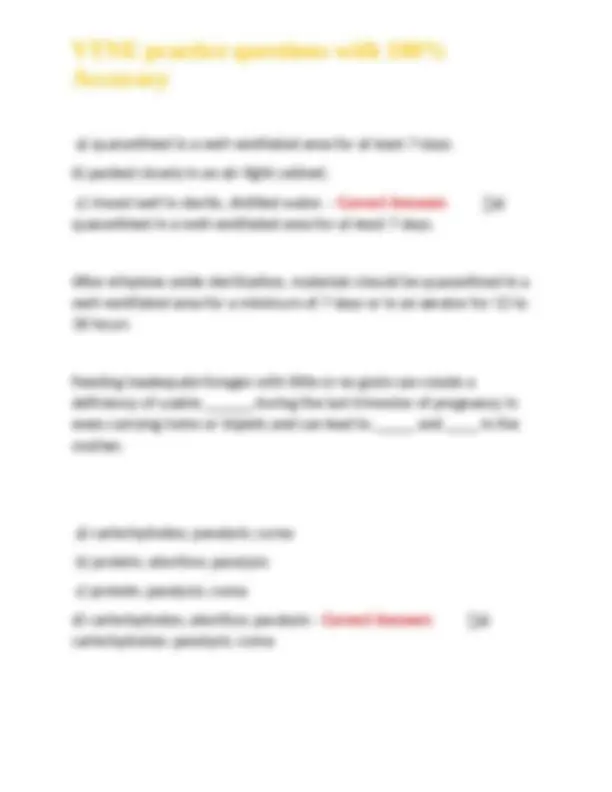
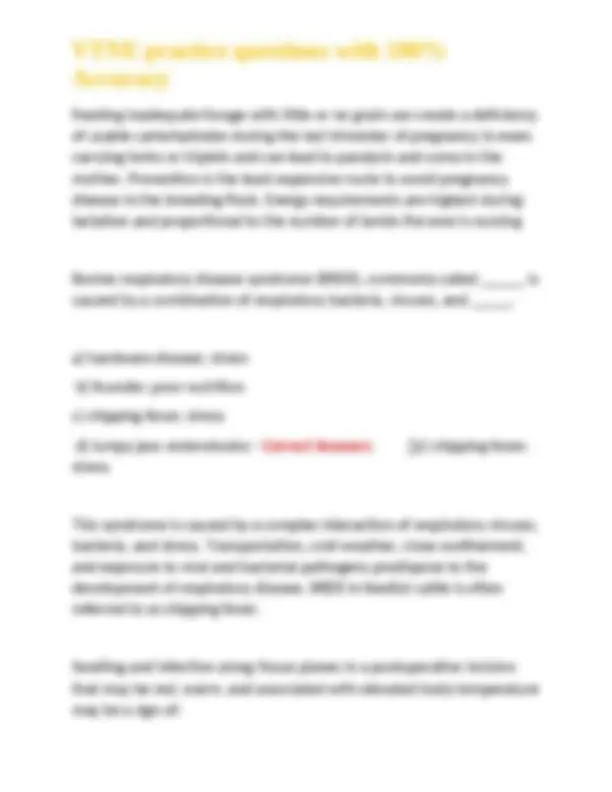
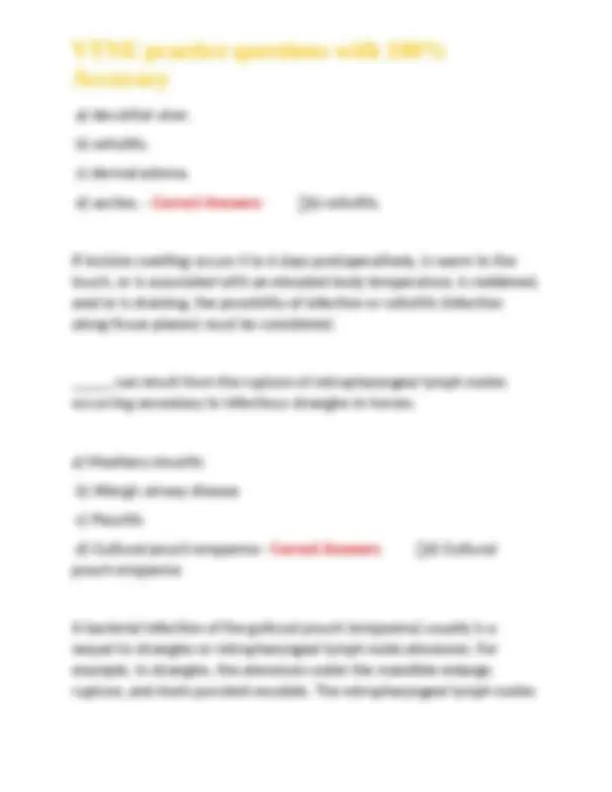
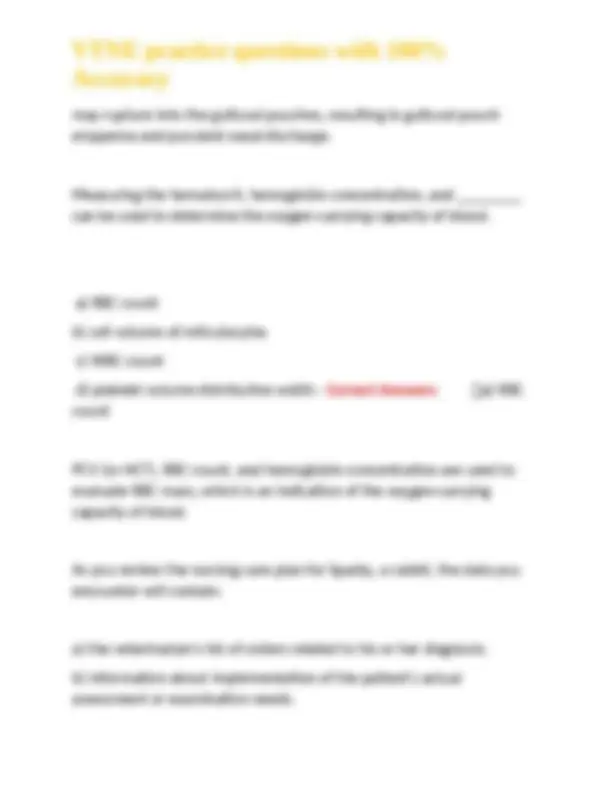
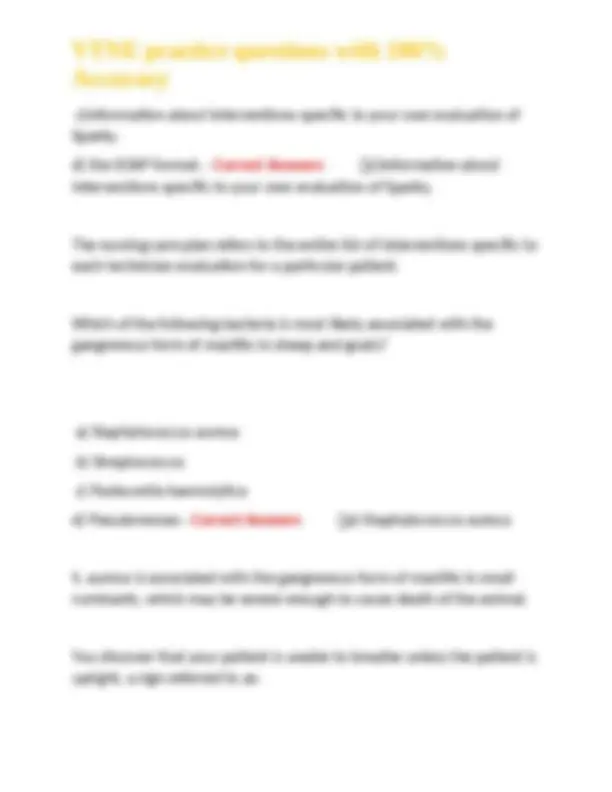
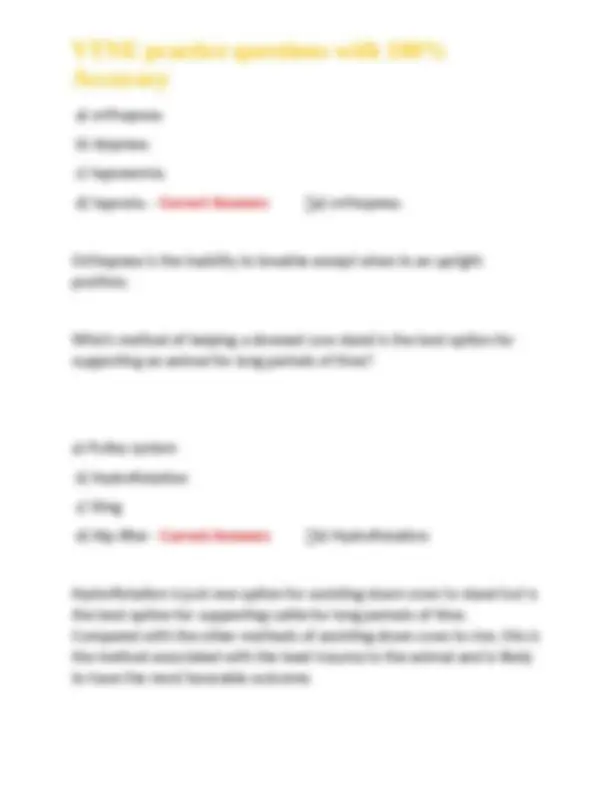
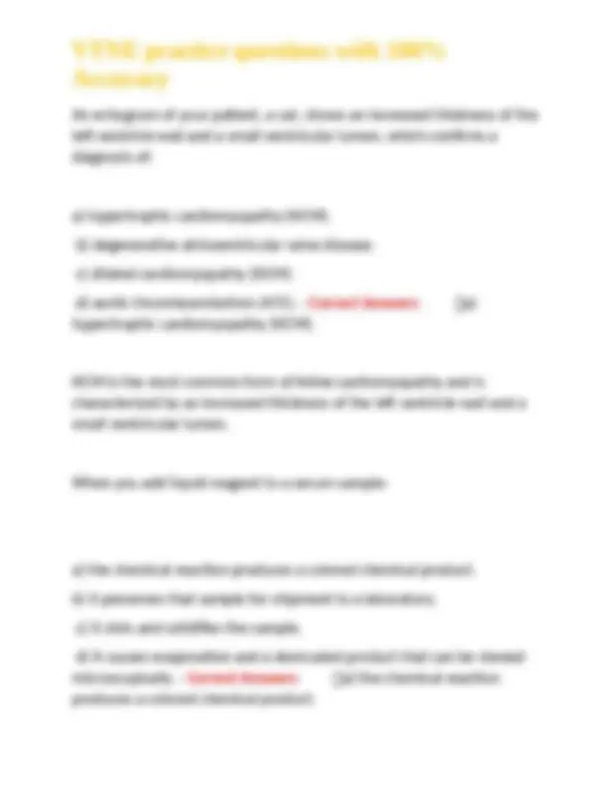

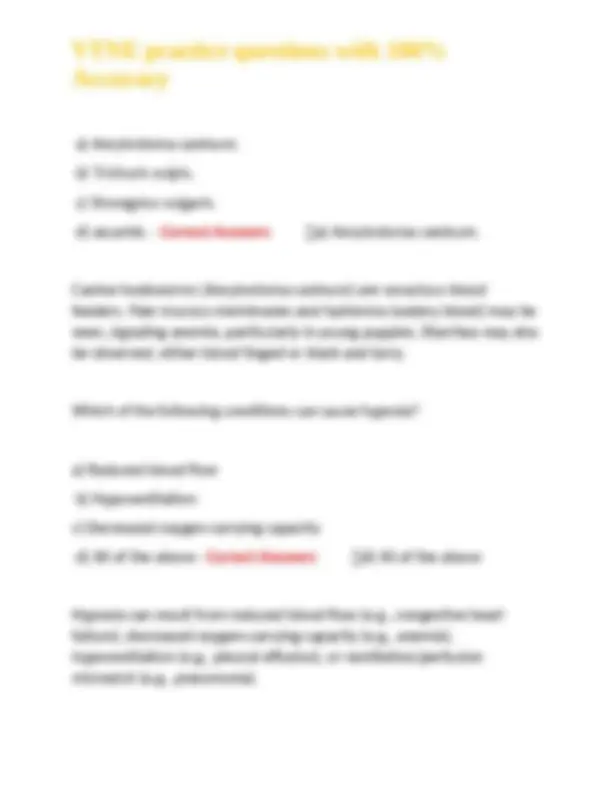
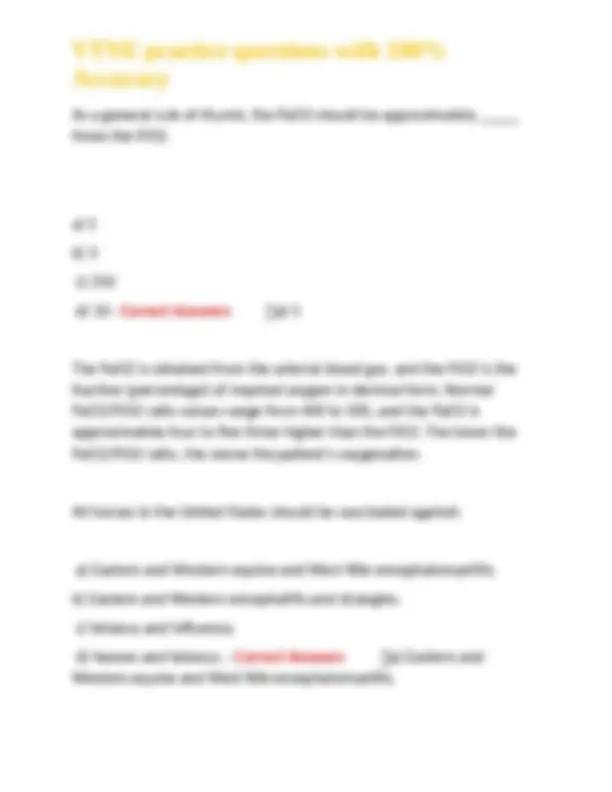
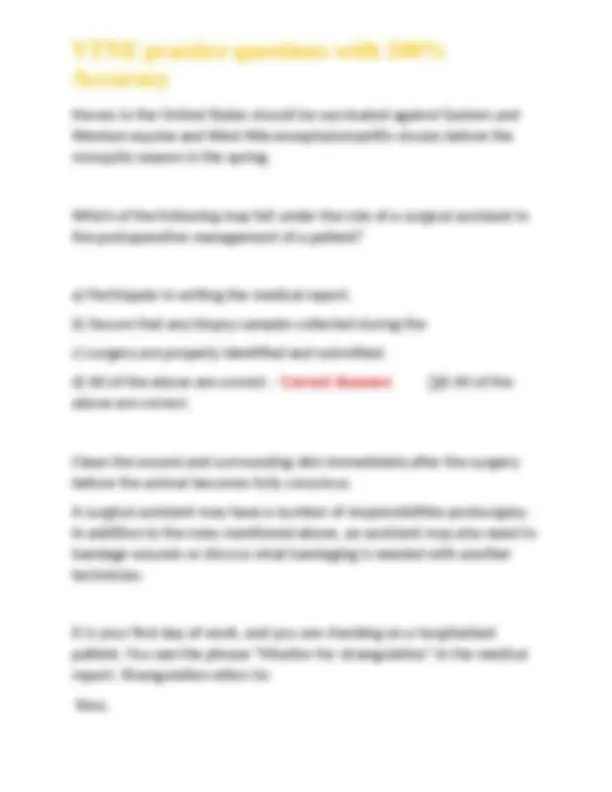
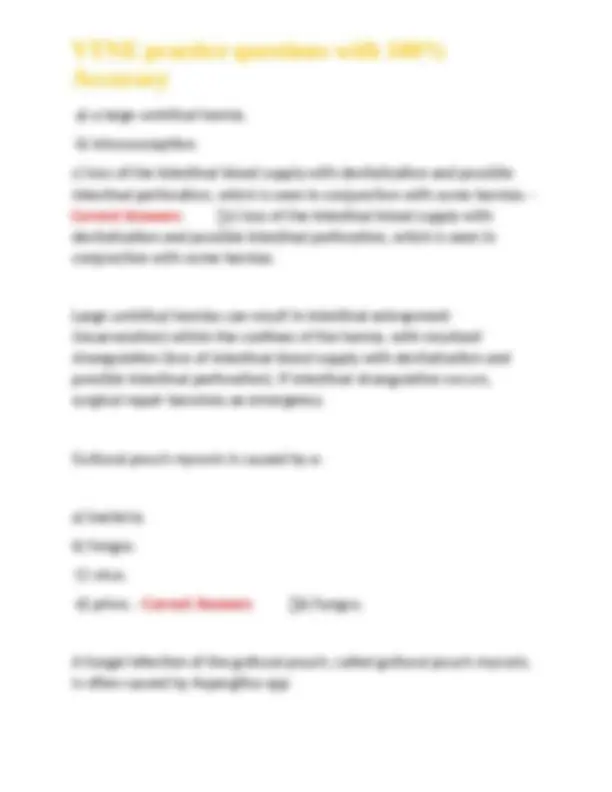
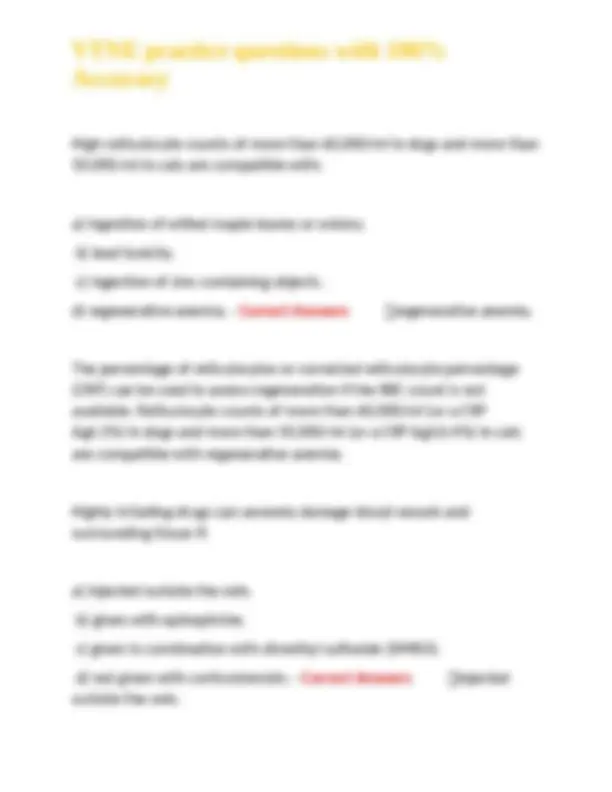
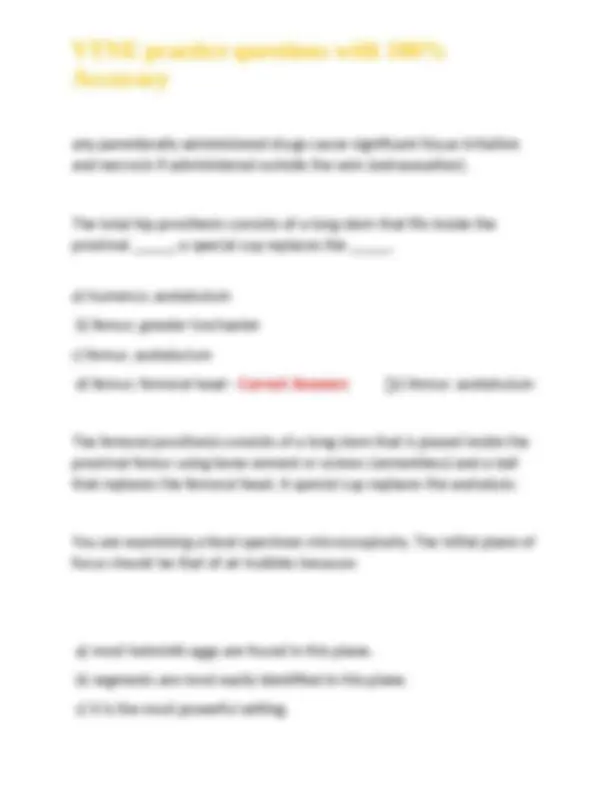
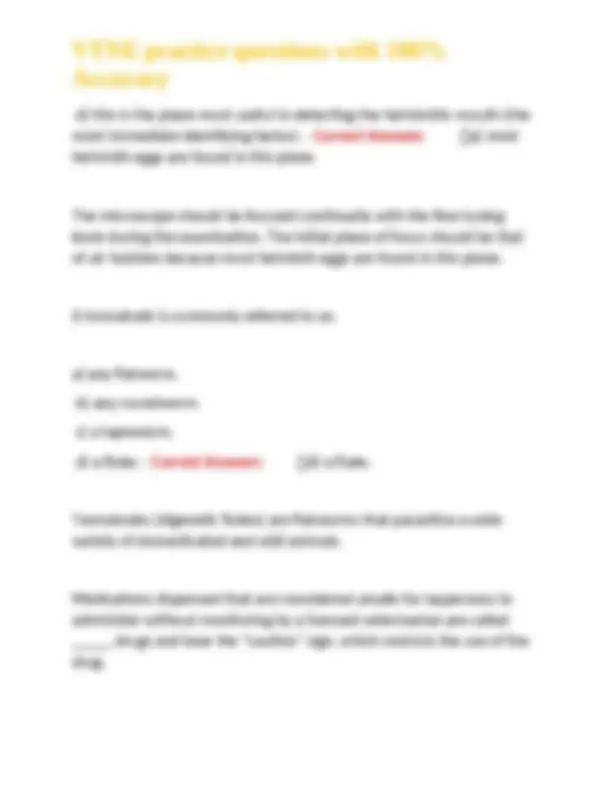
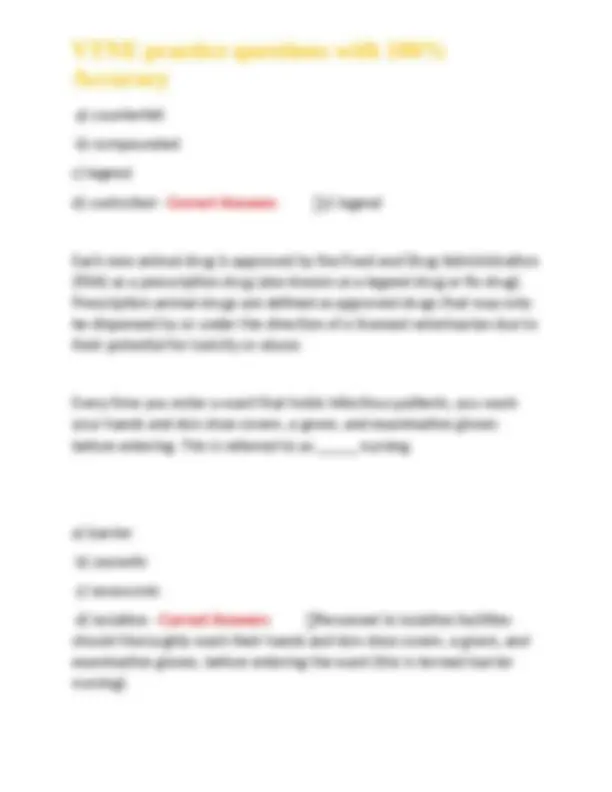
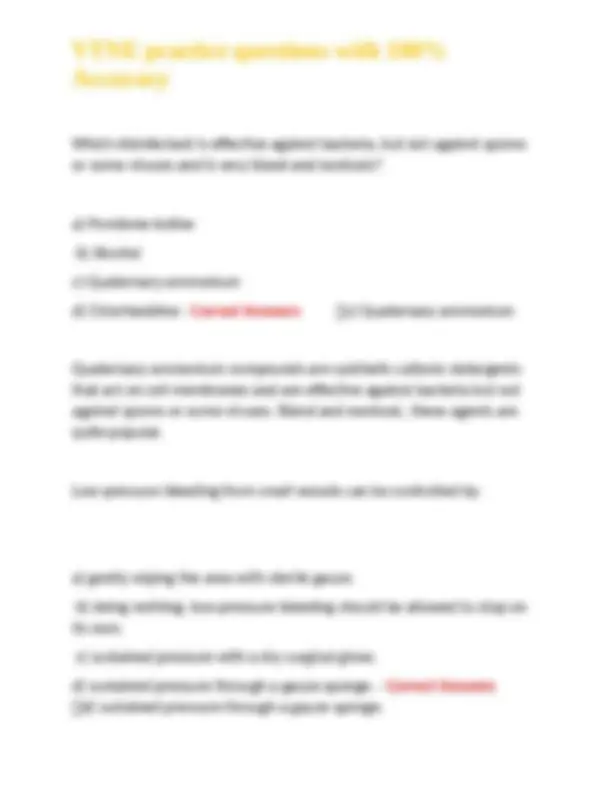
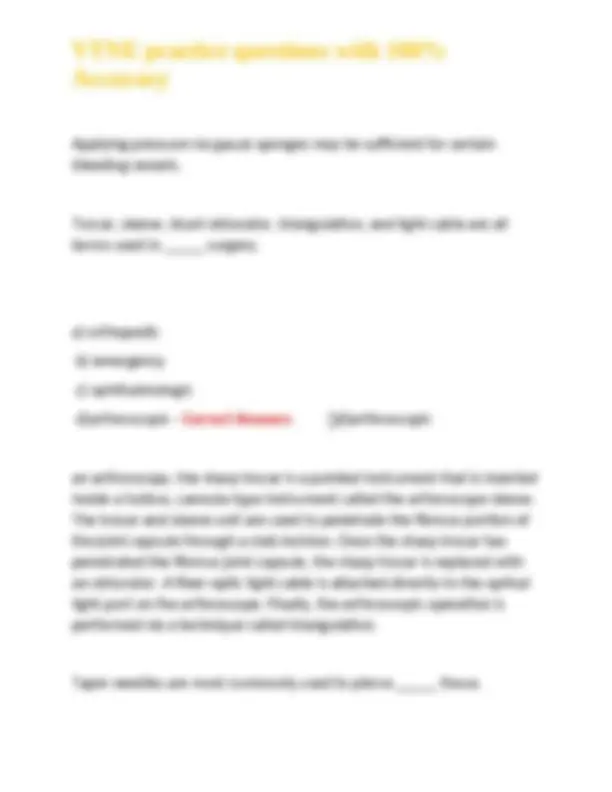
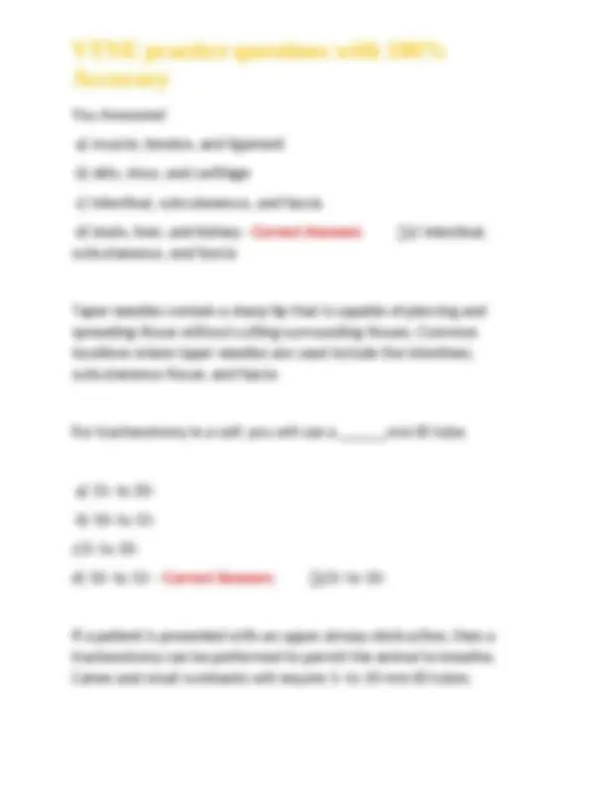


Study with the several resources on Docsity

Earn points by helping other students or get them with a premium plan


Prepare for your exams
Study with the several resources on Docsity

Earn points to download
Earn points by helping other students or get them with a premium plan
Community
Ask the community for help and clear up your study doubts
Discover the best universities in your country according to Docsity users
Free resources
Download our free guides on studying techniques, anxiety management strategies, and thesis advice from Docsity tutors
VTNE practice questions with 100% Accuracy
Typology: Exams
1 / 144

This page cannot be seen from the preview
Don't miss anything!





























































































An animal that is dehydrated before surgery may require a _____ because _____ of the cell volume occurs after rehydration. a) blood/plasma transfusion; dilution b) blood/plasma transfusion; hemoconcentration c) splenectomy; hemoconcentration d) splenectomy; sequestration - Correct Answers ✅a) blood/plasma transfusion; dilution Rehydration may necessitate a blood or plasma transfusion because dilution of the blood cell volume occurs with rehydration. Platelets in mammals: a) appear within RBC agglutinations in cases of hemolytic anemia. b ) do not have nuclei. c) appear as microfilaria in a Wright-stain smear. d) are too small to be detected, even clumped, on the feathered edge of a blood smear. - Correct Answers ✅b) Do not have a nuclei In mammals, platelets are nonnucleated fragments of cytoplasm released from megakaryocytes in the bone marrow.
Fleas are: a) endoparasites. b)pseudoparasites. c) periodic parasites. d) ectoparasties - Correct Answers ✅Ectoparasites Parasites are divided into two large groups: endoparasites (internal parasites), which include nematodes, cestodes, trematodes, protozoa, and acanthocephalans; and ectoparasites (external parasites), which include fleas. Actinobacillosis is usually treated with antibiotics, an antiinflammatory drug, and intravenous administration of: a) sodium iodide. b) penicillin c) dexamethasone. d) oxytetracycline. - Correct Answers ✅a) sodium iodide.
b) is begun during weaning and focuses on decreasing milk production and inflammation, using warm compresses. c)focuses on treating the inflammation and massaging the affected mammary gland. d) involves a decrease in milk production, coupled with cold compresses to reduce ever. - Correct Answers ✅b) is begun during weaning and focuses on decreasing milk production and inflammation, using warm compresses. Treatment is begun if galactostasis occurs during the weaning period and focuses on decreasing milk production (reducing food and water intake and preventing nursing) and decreasing inflammation with gentle application of warm compresses. An allergic disease associated with airway inflammation, bronchoconstriction, and excessive mucous production is: a) influenza. b) herpes. c) recurrent airway obstruction. d)viral arteritis. - Correct Answers ✅c) recurrent airway obstruction
Heaves, or recurrent airway obstruction (RAO), is an allergic airway disease caused by airway inflammation, narrowing of small airways (bronchoconstriction), and excessive mucus production. The analgesic effect of NSAIDs is due to: a) interaction with receptors in the central nervous system. b) interaction with specific opioid receptors in the brain and spinal cord. c) interaction with histamine receptors. d)modification of the inflammatory response. - Correct Answers ✅modification of the inflammatory response. Nonsteroidal antiinflammatory drugs (NSAIDs) provide analgesia by modifying the inflammatory response. A 10% concentration of solution contains _____ of a dug per _____ of solution. a) 1 g; 100 ml b)1 mg; 10 ml c) 10 mL; 100 mL d)100 g; 100 ml - Correct Answers ✅c) 10 mL; 100 mL
Which drugs can be administered safely via the endotracheal route? a)Atropine, lidocaine, epinephrine, naloxone, vasopressin b) Dopamine, epinephrine c) Corticosteroids, atropine, vasopressin d) Epinephrine, naloxone only - Correct Answers ✅a ) Atropine, lidocaine, epinephrine, naloxone, vasopressin Drugs that are safe to administer through an endotracheal tube are easily remembered by the acronym NAVEL (naloxone, atropine, vasopressin, epinephrine, lidocaine). Two tests that can evaluate the intrinsic and common pathways of the coagulation cascade are the activated clotting time (ACT) and the _____, which measures the time it takes for the primary platelet plug to form. a) bleeding time b) CPPT c) hemostasis d) PT - Correct Answers ✅a) bleeding time
Using laboratory testing, the coagulation cascade can be divided into two pathways that result in formation of thrombin, the "intrinsic" and "extrinsic" pathways. Two tests that can be performed in house are the bleeding time and the activated clotting time (ACT). The bleeding time measures the time it takes for the primary platelet plug to form. Artie, a Pekinese, has begun losing weight and experiences some anorexia. He is frequently suddenly exhausted. Tests indicate that Artie has _____, or disease of the heart muscle. a) cardiovascular disease b) cardiomuscular disease c) cardiomyopathy d) congestive heart failure - Correct Answers ✅c) cardiomyopathy Cardiomyopathy is a disease (-pathy) of the heart (cardi/o) muscle (my/o) In a blood smear, oxidative damage results in __________, which are RBCs in which the hemoglobin has shifted to one side of the cell, creating a clear area outlined by a thin rim of membrane. a) keratocytes
presence of portosystemic shunts, which compromise the normal functioning of liver detoxification or the enterohepatic circulation. In evaluating a blood smear: a) the counting area, where most of the evaluation takes place, is between the body and the feathered edge. b) cell morphology can only be accurately evaluated in the largest, "body" area of the smear. c) the counting area is the largest part, and is a homogenous area beginning at the end of the slide where the drop of blood was placed. d) cell morphology should only be evaluated at the feathered edge, where the cells are spread thinly and appear singly. - Correct Answers ✅a) In evaluating a blood smear: The counting area is between the body and the feathered edge and contains a monolayer of cells. In this region, RBCs, WBCs, and platelets can be identified and their morphology can be adequately evaluated. Most of the blood smear evaluation is performed in the counting area. In the body, the blood smear is thick and the cells are piled on top of each other so it is difficult to identify cells or evaluate cell morphology. At the feathered edge, many of the cells may be broken, distribution of cells may be uneven, and RBCs often lose their central zone of pallor.
Pyometra, metritis, and endometrial hyperplasia may be treated with a(n): a) onychectomy. b) anastomosis. c) urethrostomy. d) ovariohysterectomy. - Correct Answers ✅d) ovariohysterectomy. terine diseases that may require ovariohysterectomy include metritis, pyometra, uterine prolapse, endometrial hyperplasia, neoplasia, injury, neglected dystocia, and congenital abnormalities. The veterinarian uses a(n) ______ to stabilize a fracture, placing pins through the skin and bone. a) osteotome b) external fixator c) trephine d) rongeur - Correct Answers ✅b) external fixator External fixation is a means of stabilizing fractures using pins or wire placed through the skin and bone.
b)strength of the electrical impulse expressed in millimeters per millivolt. c)time expressed in millimeters per second. d) strength of the electrical impulse expressed in millivolts. - Correct Answers ✅d) strength of the electrical impulse expressed in millivolts. All standard ECG paper is composed of narrow vertical and horizontal lines 1 mm apart, creating a grid of 1-mm boxes. Vertical measurements represent strength of the electrical impulse expressed in millivolts (mV) and horizontal measurements represent time expressed in seconds (sec). A surgeon removes a devitalized section of intestine and then performs a(n): a) onychectomy. b) urethrostomy. c) ovariohysterectomy. d) anastomosis. - Correct Answers ✅d) anastomosis. Anastomosis is performed after damaged tissue or a tumor requires a segment of the gastrointestinal tract to be removed.
Surgically prepared skin is considered _______, not ________. a) sterile; aseptic b) aseptic; sterile c) scrubbed; aseptic d) clean; aseptic - Correct Answers ✅b) aseptic; sterile The skin is prepared with aseptic technique prior to surgery, but the skin should never be considered sterile. In evaluating an antibody response using serologic testing, the first sample is taken: a) only after the animal has had time to develop a humoral immune response. b) when the patient initially shows clinical signs and is presented for examination. c)only after vaccination to ensure accuracy. d)within 1 to 3 days of the second sample, when titer increases are most meaningful. - Correct Answers ✅b) when the patient initially shows clinical signs and is presented for examination.
c) The collection tube should be inverted 10-15 times before further processing to ensure the RBCs, WBCs, and platelets are evenly dispersed in the sample. d) None of the above. A, B, and C are all true. - Correct Answers ✅d) None of the above. A, B, and C are all true. All of the answers are true for collecting a CBC from any animal species. Samples are collected in a collection tube containing an anticoagulant and should be labeled immediately with identifying information as well as the date and time the sample was collected. Fescue toxicosis is a nutritional disease that can involve lameness, tail- tip necrosis, abortion, and/or decreased milk production. This disease affects: a) pigs. b)sheep. c) both B and C. d) horses. - Correct Answers ✅b)sheep. Cattle and sheep suffer from fescue toxicosis, as demonstrated in Table 10-1.
A(n) _______ is a detailed step-by-step description for performing a test and operating an instrument. a) Levy-Jennings chart b) QC c) iSTAT d) SOP - Correct Answers ✅d) SOP It is important to have a standard operating procedure (SOP) for each instrument. An SOP is a detailed step-by-step description for performing a test and operating an instrument. This ensures that the test is performed in a uniform fashion every time, whether by the same technician or multiple technicians. Your patient's fecal sample shows streaks of blood on the outsides of otherwise normally formed stools, a symptom you quickly identify as: a) hematochezia. b) melena. c) tenesmus. d) hematemesis. - Correct Answers ✅a) hematochezia.
The most common nutritional disease of pot-bellied pigs is obesity; however, many stunted and malnourished pigs are also seen owing to their owners' misguided attempts to keep them small. You examine a microhematocrit tube after centrifugation. The buffy coat: a) is the uppermost layer and contains plasma. b) represents the middle layer and contains packed red blood cells (RBCs). c) contains white blood cells (WBCs) and platelets and is the middle layer between plasma and RBCs. d) is in the lower portion and contains packed RBCs. - Correct Answers ✅c) contains white blood cells (WBCs) and platelets and is the middle layer between plasma and RBCs. After centrifugation, there are three visible components of the blood in the microhematocrit tube: a column of packed RBCs at the bottom, a buffy coat layer of WBCs and platelets just above the packed RBCs, and finally, plasma at the top. A unicellular parasite is: a) a protozoan.
b) a zoonosis. c) coenurus. d) a trematode. - Correct Answers ✅a) a protozoan. A protozoan is a unicellular organism. Some protozoans are parasitic in human beings and in wild and domestic animals. Which of the following statements is false regarding calves with diarrhea? a) Milk and milk products should be warmed before being offered. b) Cows should be vaccinated before calving. c) Poor sanitation and poor nutrition can contribute to the development of diarrhea. d) Warm intravenous fluids should be administered and supplemented with dextrose and bicarbonate as needed. - Correct Answers ✅a) Milk and milk products should be warmed before being offered. A variety of management conditions, including poor nutrition and improper sanitation, may cause or contribute to the development of diarrhea in calves. Sick, weak calves should be started on warm, balanced intravenous fluids supplemented with dextrose and